SECURITIES AND EXCHANGE COMMISSION
Washington, D.C. 20549
FORM 6-K
Report of Foreign Private Issuer
Pursuant to Rule 13a-16 or 15d-16 of the
Securities Exchange Act of 1934
For the month of June, 2019
Commission File Number 1-14668
COMPANHIA PARANAENSE DE ENERGIA
(Exact name of registrant as specified in its charter)
Energy Company of Paraná
(Translation of Registrant's name into English)
Rua Coronel Dulcídio, 800
80420-170 Curitiba, Paraná
Federative Republic of Brazil
+55 (41) 3331-4011
(Address of principal executive offices)
Indicate by check mark whether the registrant files or will file annual reports under cover Form 20-F or Form 40-F. Form 20-F ___X___ Form 40-F _______
Indicate by check mark whether the registrant by furnishing the information contained in this Form is also thereby furnishing the information to the Commission pursuant to Rule 12g3-2(b) under the Securities Exchange Act of 1934.
Yes _______ No ___X____

Companhia Paranaense de Energia
Corporate Taxpayer's ID (CNPJ/MF) 76.483.817/0001-20
State Registration 10146326-50
Publicly-Held Company - CVM 1431-1
www.copel.com copel@copel.com
Rua Coronel Dulcídio, 800, Batel - Curitiba - PR
CEP 80420-170
QUARTERLY INFORMATION
ITR
March / 2019

CONTENTS |
FINANCIAL STATEMENTS | | 3 |
Statements of Financial Position | 3 | |
Statements of Income | 5 | |
Statements of Comprehensive Income | 6 | |
Statements of Changes in Equity | 7 | |
Statements of Cash Flows | 8 | |
Statements of Added Value | 10 | |
NOTES TO THE FINANCIAL STATEMENTS | | 12 |
1 | Operations | 12 | |
2 | Concessions and Authorizations | 14 | |
3 | Basis of Preparation of the Quarterly Information | 17 | |
4 | Significant Accounting Policies | 20 | |
5 | Cash and Cash Equivalents | 22 | |
6 | Bonds and Securities | 22 | |
7 | Trade Accounts Receivable | 23 | |
8 | CRC Transferred to the Paraná State Government | 24 | |
9 | Net Sectorial Financial Assets and Liabilities | 25 | |
10 | Accounts Receivable - Concessions | 26 | |
11 | Contract assets | 27 | |
12 | Other Receivables | 29 | |
13 | Taxes | 30 | |
14 | Prepaid Expenses | 32 | |
15 | Receivables from Related Parties | 32 | |
16 | Judicial Deposits | 33 | |
17 | Investments | 34 | |
18 | Property, Plant and Equipment | 37 | |
19 | Intangible assets | 41 | |
20 | Payroll, Social Charges and Accruals | 42 | |
21 | Accounts Payable to Suppliers | 42 | |
22 | Borrowings | 43 | |
23 | Debentures | 48 | |
24 | Post-Employment Benefits | 50 | |
25 | Sectorial Charges Due | 52 | |
26 | Research and Development and Energy Efficiency | 52 | |
27 | Accounts Payable Related to Concessions | 53 | |
28 | Right-of-use asset and lease liability | 53 | |
29 | Other Accounts Payable | 54 | |
30 | Provisions for Lawsuits and Contingent Liabilities | 55 | |
31 | Equity | 61 | |
32 | Net Operating Revenue | 63 | |
33 | Operating Costs and Expenses | 66 | |
34 | Financial Results | 69 | |
35 | Operating Segments | 70 | |
36 | Financial Instruments | 73 | |
37 | Related Party Transactions | 85 | |
38 | Commitments | 87 | |
39 | Insurance | 89 | |
40 | Additional information to the Statement of Cash Flows | 89 | |
41 | Events after the reporting period | 90 | |
COMMENTS ON PERFORMANCE | | 91 |
INDEPENDENT AUDITOR'S REPORT | | 102 |
REPORT OF THE SUPERVISORY BOARD ON THE INTERIM FINANCIAL STATEMENTS FOR THE FIRST QUARTER OF 2019 | | 104 |
DECLARATION | | 105 |
FINANCIAL STATEMENTS
Statements of Financial Position
as of March 31, 2019 and December 31, 2018
All amounts expressed in thousands of Brazilian reais

3
Statements of Financial Position
as of March 31, 2019 and December 31, 2018 (continued)
All amounts expressed in thousands of Brazilian reais

4
Statements of Income
for the quarters ended March 31, 2019 and 2018
All amounts expressed in thousands of Brazilian reais
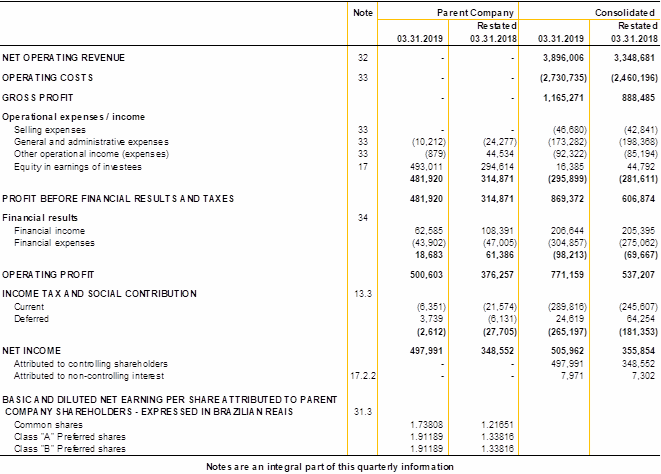
5
Statements of Comprehensive Income
for the quarters ended March 31, 2019 and 2018
All amounts expressed in thousands of Brazilian reais

6
Statements of Changes in Equity
for the quarters ended March 31, 2019 and 2018
All amounts expressed in thousands of Brazilian reais

7
Statements of Cash Flows
for the quarters ended March 31, 2019 and 2018
All amounts expressed in thousands of Brazilian reais
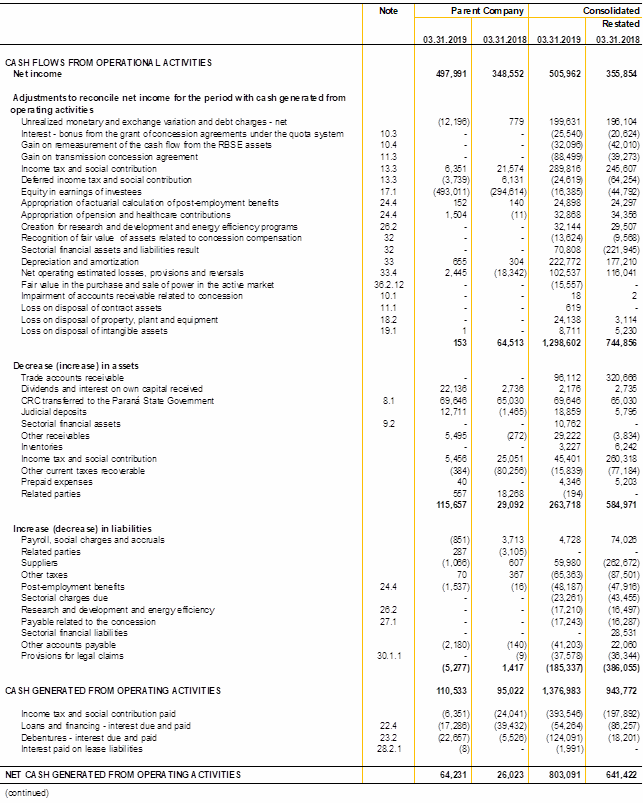
8
Statements of Cash Flows
for the quarters ended March 31, 2019 and 2018 (continued)
All amounts expressed in thousands of Brazilian reais

9

Statements of Added Value
for the quarters ended March 31, 2019 and 2018
All amounts expressed in thousands of Brazilian reais

10
Statements of Added Value
for the quarters ended March 31, 2019 and 2018 (continued)
All amounts expressed in thousands of Brazilian reais

11
NOTES TO THE FINANCIAL STATEMENTS
for the quarter ended March 31, 2019
All amounts expressed in thousands of Brazilian reais
1 Operations
Companhia Paranaense de Energia (Copel, Company or Parent Company), with its head office located at Rua Coronel Dulcídio, 800, Curitiba - State of Paraná, is a publicly-held mixed capital company controlled by the State of Paraná and its shares are traded at Corporate Governance Level 1 of the Special Listing Segments of B3 S.A. - Brasil, Bolsa Balcão Stock Exchange and also on the New York Stock Exchange (NYSE) and on the Madrid Stock Exchange in the Latin American segment (Latibex).
The core activities of Copel and its subsidiaries, which are regulated by the Brazilian Electricity Regulatory Agency (ANEEL), linked to the Brazilian Ministry of Mines and Energy (MME), are to carry out research, study, planning, and asset building activities related to the generation, transformation, distribution and trading of energy in any of its forms, primarily electricity. Furthermore, Copel participates in consortiums and in private sector and mixed-capital companies for the purpose of engaging in activities, primarily in the fields of energy, telecommunications and natural gas.
1.1 Copel’s equity interests
Copel has direct and indirect interests in subsidiaries (1.1.1), joint ventures (1.1.2), associates (1.1.3) and joint operations (1.1.4).
12
1.1.1 Subsidiaries
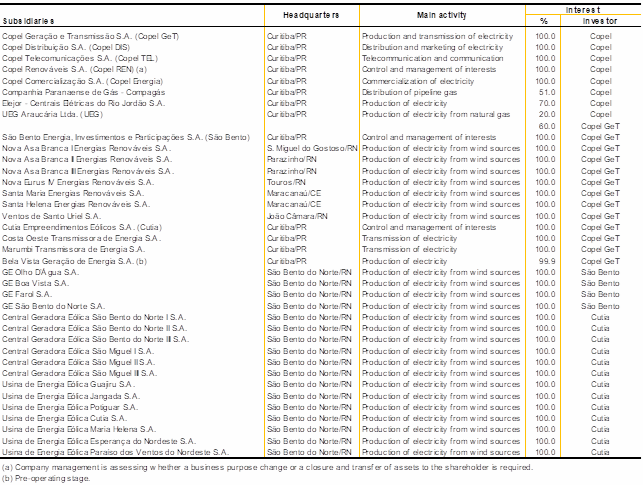
1.1.2 Joint ventures

13
1.1.3 Associates

1.1.4 Joint operations (consortiums)

2 Concessions and Authorizations
2.1 Concession contracts or authorizations obtained by Copel
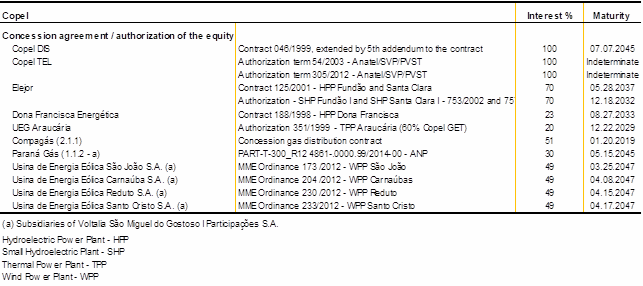
2.1.1 Compagás
Compagás is a party to a concession agreement entered into with the Concession Grantor, the State of Paraná, setting July 6, 2024 as the expiration date of the concession.
On December 7, 2017, the State of Paraná published Supplementary Law 205, introducing a new interpretation of the expiration of the concession, understanding that expiration will be on January 20, 2019. Considering that up to this date the extension/bidding of the concession has not yet occurred, the law provides that the concession operator may, after the expiration of the term, remain responsible for its performance until the assumption of the new concession operator, subject to the conditions established.
14
The Management of Compagás, its Parent company and other shareholders are challenging the effects of the aforesaid law since they understand that it conflicts with the provisions of the concession agreement currently in force. Compagás filed a lawsuit challenging the early termination of the concession and, on October 30, 2018, a preliminary injunction was granted. The Company is awaiting the trial of the merit of the case.
Considering that the lawsuit continues outstanding and the law continues in force, it was necessary to consider these effects in the financial statements. The impacts recorded are as follows:

Management will continue to make its best efforts to protect the Company’s interests, aiming at appropriately settle the impacts of the new interpretation given by the Concession Grantor and find alternatives necessary to maintain the concession in a sustainable manner.
15
2.2 Concession contracts or authorizations obtained by Copel Get and its investees
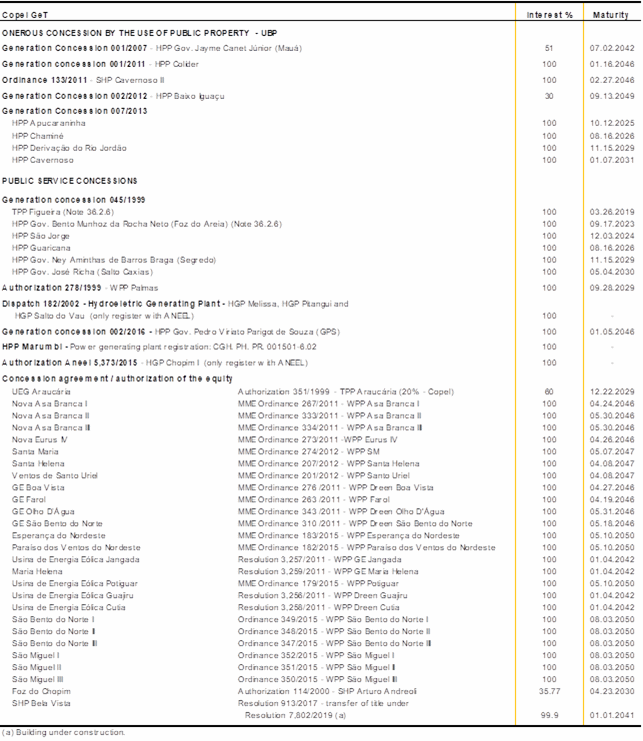
16
3 Basis of Preparation
3.1 Statement of compliance
The quarterly information is being presented considering the provisions of CPC 21(R1) and IAS 34 – Interim Financial Reporting. Consequently, certain information contained in the notes to the financial statements for the year ended December 31, 2018, and which was not subject to modifications in the first three months of 2019, is not being presented. Therefore, this quarterly information should be read together with the financial statements as at December 31, 2018, available on the websites of the Brazilian Securities and Exchange Commission - CVM and Copel.
The Company’s Management believes that all the relevant information used in its management is evidenced in the individual and consolidated quarterly information.
The quarterly information was approved by Management and authorized for issue on May 14, 2019.
17
3.2 Functional and presentation currency
The quarterly information is presented in Brazilian Reais, which is the functional and presentation currency of the Company. Balances herein have been rounded to the nearest thousand, unless otherwise indicated.
3.3 Basis of measurement
The quarterly information was prepared based on the historical cost, except for certain financial instruments and investments measured at fair value, as described in the respective accounting policies and notes.
3.4 Use of estimates and judgments
In the preparation of this quarterly information, Management used judgments, estimates and assumptions that affect the application of accounting policies and the reported amounts of assets, liabilities, income and expenses of Copel and its subsidiaries. Actual results may differ from those estimates.
Estimates and assumptions are reviewed on a continuous basis. Changes in estimates are recognized in the period in which they occur.
Information about the use of estimates and judgment referring to the adoption of accounting policies which impact the amounts recognized in the quarterly information is the same as that disclosed in note 3.4 to the financial statements at December 31, 2018, excepting the information disclosed in note 4.1.1 to this quarterly information.
3.5 Management’s judgment on going concern
Management has concluded that there are no material uncertainties that cast doubt on the Company’s ability to continue as a going concern. No events or conditions were identified that, individually or in the aggregate, may raise significant doubts on its ability to continue as a going concern.
The main bases of judgment used for such conclusion are: (i) main activities resulting from long-term concessions; (ii) robust equity; (iii) strong operating cash generation, including financial capacity to settle commitments entered into with financial institutions; (iv) historical profitability; and (v) fulfillment of the objectives and targets set forth in the Company's Strategic Planning, which is approved by Management, monitored and reviewed periodically, seeking the continuity of its activities.
18
3.6 Restatement
CPC 47 / IFRS 15 – Clarifications to IFRS 15 – Revenue from Contracts with Customers and CPC 48 / IFRS 9 – Financial Instruments have been effective since January 1, 2018. During the closing of fiscal year 2018, specifically for the electricity transmission activity, the Company reassessed its operations in light of the new accounting standards and concluded that the balance of the public electricity transmission contracts signed with the Concession Grantor to build, operate and maintain the high voltage lines and substations should be classified and presented as contract assets instead of as financial assets, as they were previously presented, since the consideration for this asset is conditional upon fulfillment of other contractual performance obligations.
For this quarterly information, the new understanding had an impact on the result for the first quarter of 2018, due to the equity valuation adjustment in the remeasurement of assets of Copel GeT's equity interests, and on the statement of cash flows, due to the reclassification of the contract assets, previously classified with intangible assets. The effects on the financial statements, restated for purposes of comparison, are shown below:
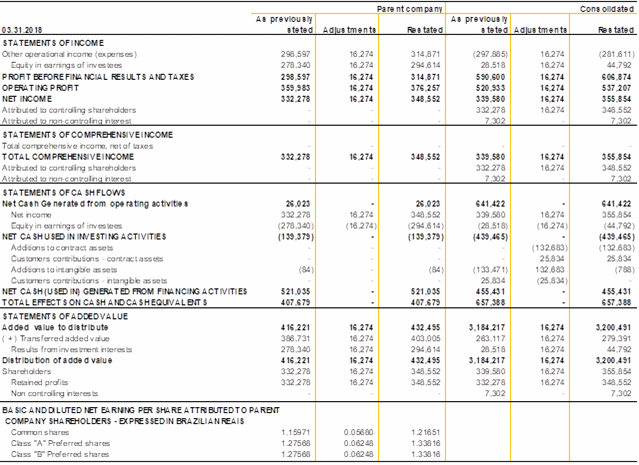
19
4 Significant Accounting Policies
The Company’s accounting policies are consistent with those presented in the financial statements for the year ended December 31, 2018, except for the policies disclosed in note 4.1.
4.1 Standards applicable to the Company effective January 1, 2019
4.1.1 CPC 06 (R2)/IFRS 16 - Leases
The pronouncement replaces CPC 06 (R1) / IAS 17 - Leases, as well as related interpretations (ICPC 03 / IFRIC 4, SIC 15 and SIC 27). The adoption of the new standard eliminates the operating lease accounting for the lessee, presenting a single lease model consisting of initially recognizing all leases in assets and liabilities at present value; and recognizing the amortization of the right to use the asset and lease interest separately in the statement of income.
Transition method
The Company applied the modified retrospective transition method, which does not require the presentation of comparative information, and the liability and the right-of-use asset are recognized at the present value of the remaining installments. Accordingly, the information for prior years continues being presented in accordance with the previous standard.
The Company analyzed its operating lease contracts and applied this pronouncement only to contracts in force on January 1, 2019 and that have been previously identified as leases.
In conformity with CPC 06 (R2) / IFRS 16, the Company elected to adopt the recognition exemptions foreseen for short-term leases (lease term of 12 months or less) and low value assets leases, such as computers, printers and mobile devices of less than R$18. These contracts are recognized as operating lease costs and/or expenses on a straight line basis as provided for in the standard, over the lease contract term.
The Company has land lease contracts for the development of wind power generation projects that provide for minimum lease payments during the study/construction period and variable lease payments during the period of commercial operation. For lease contracts that at the date of application of the standard are subject to minimum payments, the Company recognized a right-of-use asset and a lease liability. Lease agreements that are already in commercial operation are recognized by the Company in its statement of income, when the event or condition is fulfilled, as leases and rentals, in operating costs and/or expenses.
Use of judgment
Lessee’s incremental borrowing rate
For all lease contracts with related parties and third parties, the Company considered the interest rate required to acquire assets in similar conditions of those leased as of the date of execution of the lease contract. The rate adopted by the Company considers the cost of the last borrowing taken out, based on the Interbank Deposit Certificate (CDI) rate plus a risk spread applicable to the Company. On initial adoption, the rate used was 9.10% p.a.
20
Lease term for contracts with indefinite term.
The Company has lease contracts with indefinite term. For these contracts, the estimated term adopted considered a maximum term extension by 60 months.
Effects from initial application
The new requirements of CPC 06 (R2)/IFRS 16 generated the following impacts on the recognition and presentation of lease and rental contracts.

The effects from initial adoption are presented in note 28.
4.1.2 ICPC 22/IFRIC 23 – Uncertainty Over Income Tax Treatment
The interpretation explains how to apply the recognition and measurement requirements of CPC 32 – Income Taxes when there is uncertainty over a tax treatment. In accordance with certain requirements, such as where the tax authority is most likely not to accept certain treatment, the entity shall recognize and measure its current or deferred tax, asset or liability, applying the requirements of CPC 32 based on taxable profit (tax loss), tax bases, unused tax losses, unused tax credits and ruling statutory tax rates, considering this uncertainty.
The Company evaluated the income tax treatments and concluded that the application of the standard did not have impacts on its results.
21
5 Cash and Cash Equivalents

These comprise cash on hand, deposits with banks and short-term highly-liquid investments, which can be redeemed in cash within 90 days from the investment date. Temporary short-term investments are recorded at cost at the reporting date, plus earnings accrued. Cash and cash equivalents are subject to an insignificant risk of change invalue.
Financial investments of the Company and its subsidiaries refer to Bank Deposit Certificates - CDBs and Repurchase Agreements, which are the sale of a security with the commitment of the seller (Bank) to repurchase it, and of the purchaser to resell it in the future. Investments are remunerated between 78% and 100.8% of Interbank Deposit Certificate (Certificado de Depósito Interbancário - CDI) interest.
6 Bonds and Securities
The Company and its subsidiaries have securities that yield variable interest rates. The term of these securities ranges from 1 to 59 months from the end of the reporting period.

22
7 Trade Accounts Receivable

7.1 Energy installments plan
The trade accounts receivable renegotiated are discounted to present value as of March 31, 2019, taking into consideration the future value, the maturity dates, the dates of settlement and the discount rate ranging from 0.07% to 4.26% p.m.
7.2 Electricity Trading Chamber - CEEE
The Company challenges in court the application filed for exclusion of responsibility in order to postpone the obligation of Colíder HPP to supply energy in connection with energy sales by the Company (Note 18.4).
Due to the success in the filing of application for preliminary injunction in the ordinary lawsuit, the Company has a receivable of R$190,856 for energy supply in the period January to October 2015, measured at the PLD amount.As the receipt of this amount is uncertain, expected credit losses in the amount of R$119,665 were recorded, corresponding to the difference between the PLD amount and the contractual amount. The remaining balance of R$71,191 corresponds to the clearly legal right receivable for the energy supply, irrespective of any litigation.
23
Also in relation to this lawsuit the amount of R$43,844, related to energy supply measured at the PLD amount, was not recognized due to the uncertainty on the related lawsuit merit.
7.3 Expected credit losses

8 CRC Transferred to the Paraná StateGovernment
The Company’s Management and the Paraná State Government formalized on October 31, 2017 the fifth amendment to the agreement for renegotiation of the Account for Compensation of Income and Losses - CRC. The State of Paraná complied with the agreed terms and made the payments of the monthly interest until December 2017.With the end of the grace period, the State of Paraná has strictly complied with the payments under the agreed terms, there remaining 73 monthly installments to be paid.
8.1 Changes in CRC

8.2 Maturity of non-current installments

24
9 Net Sectorial Financial Assets and Liabilities
9.1 Composition of net sectorial financial assets and liabilities balances per tariffcycle


25
9.2 Changes in net sectorial financial assets and liabilities

10 Accounts Receivable - Concessions

10.1 Power distribution service concession

10.2 Piped gas distribution service concession

26
10.3 Bonus from the grant of concession agreements under the quotasystem

10.4 Remeasurement of RBSEassets

On June 27, 2017, ANEEL published Resolution 2,258 establishing the Annual Permitted Revenues (RAP) for the 2017-2018 tariff cycle, considering a court decision on the injunction of April 11, 2017 related to a lawsuit filed by three business associations, which determines the deduction of the“compensation”, provided for in article 15, paragraph 2 of Law 12,783/2013. The same decision was applied for the current 2018-2019 cycle, according to ANEEL Resolution 2,408 of June 26, 2018.
The compensation being challenged in court related to the cost of equity calculated for the RBSE assets from January 2013 to June 2017, at the time of filing of the lawsuit, is R$201,795.
Based on the opinion of its legal counsel, Copel GeT understands that this is a provisional decision and is not against Copel GeT’s right to receive the amounts related to RSBE assets, which are guaranteed by Law. Therefore, the receivables related to the compensation considered in the receipt flow of this asset are recorded in non-currentassets.
10.5 Power generation concession contract

11 Contract assets

27
11.1 Power distribution service concession contract

During the construction phase, the costs of borrowings and debentures are capitalized. In the first quarter of 2019, these costs totaled R$1,621 at the average rate of 0.09% p.a. (R$1,003, at the average rate of 0.06% p.a. in the first quarter of 2018, capitalized in contract assets).
11.2 Piped gas distribution service concession contract

11.3 Transmission service concession contract

28
12 Other Receivables

12.1 Credits on purchases of gas - Compagás
This balance refers to the gas acquisition of contracted and guaranteed volumes, higher than those actually withdrawn and used, and contains a future compensation clause. Compagás has the right to use the gas in subsequent months, and can compensate the volume contracted and not consumed until 2022. According to the contractual provisions and consumption perspectives, derived from the review of the projects and scenarios for the next years, Compagás estimates to fully offset the contracted volumes in the course of its operation. The contracts with Petrobras provide for the right to dispose of this asset. The expiration date of the concession is in discussion with the Concession Grantor, as described in Note 2.1.1.
12.2 CDE Transfer
Balance to be transferred by the CDE referring to tariff discounts on the tariffs applicable to users defined in accordance with article 13, item VII, of Law 10,438/2002 and Decree 7,891/2013. The amount transferred to Copel DIS for the period from June 2017 to May 2018, in accordance with Resolution 2,255/2017, was R$49,304 per month. As from June 2018, this amount was changed to R$62,699 per month, by Ratifying Resolution 2,402, dated 6/19/2018, which approved the result of the last Annual TariffAdjustment.
29
13 Taxes
13.1 Deferred income tax and social contribution
13.1.1 Changes in deferred income tax and social contribution


30
13.1.2 Realization of deferred taxes

13.1.3 Unrecognized tax credits
As of March 31, 2019, UEG Araucária did not recognize income tax and social contribution credits on income tax and social contribution tax losses in the amount of R$38,600 because at present there is no reasonable assurance of generation of future taxable profits sufficient to allow the utilization of these tax credits.
13.2 Other taxes recoverable and other tax obligations

31
13.3 Reconciliation of provision for income tax (IRPJ) and social contribution (CSLL)
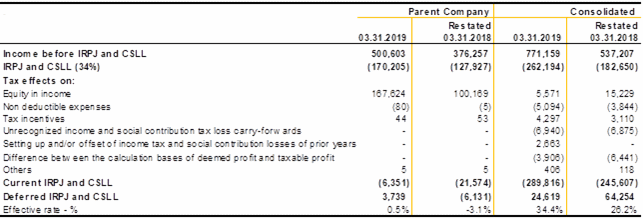
14 Prepaid Expenses

14.1 Hydrological risk renegotiation(GSF)

15 Receivables from Related Parties

32
15.1 Copel DIS – Financing transferred - STN
The Company transferred loans and financing to its wholly-owned subsidiaries at the time of constitution in 2001. However, since the contracts for the transfers to the subsidiaries were not formalized with the financial institutions, they remain recognized in the Parent company.
The balance with Copel DIS refers to the National Treasury Department – STN financing transferred with the same levy of charges borne by the Company (Note 22) and shown as obligations for loans and financing at Copel DIS.
15.2 Wind farms – Loan agreements
On March 14, 2019, loan agreements were entered into by and between Copel (lender) and the wind farms (borrowers), with the approval of limits plus IOF (tax on financial transactions) and interest of 119% of the CDI, aimed at providing funding for the borrowers’ activities and business.These loans were settled on April 30, 2019.

16 Judicial Deposits

33
17 Investments
17.1 Changes in investments


34
17.2 Subsidiaries with non-controlling interests
17.2.1 Summarized financial information
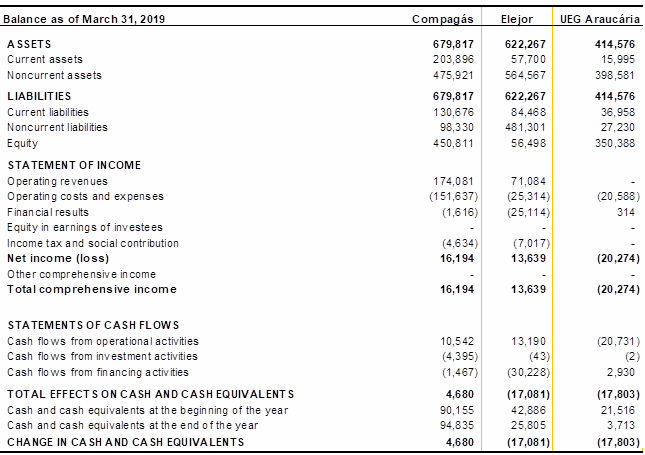
17.2.2 Changes in equity attributable to non-controllingshareholders

35
17.3 Total balances of the groups of assets, liabilities, profit or loss and equity interest in commitments and contingent liabilities of the main jointventures
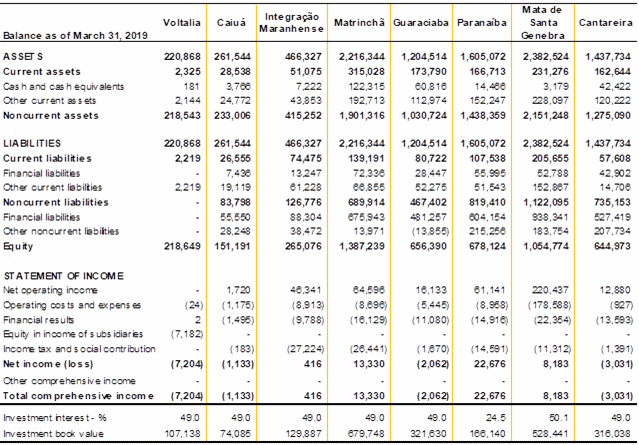
As of March 31, 2019, Copel's interest in the commitments assumed from its joint ventures is equivalent to R$40,284 (R$81,263 as of December 31, 2018) and in contingent liabilities is equivalent to R$17,761 (R$40,324 as of December 31, 2018).
36
17.4 Total balances of the groups of assets, liabilities, profit or loss and equity interest in contingent liabilities of the mainassociates
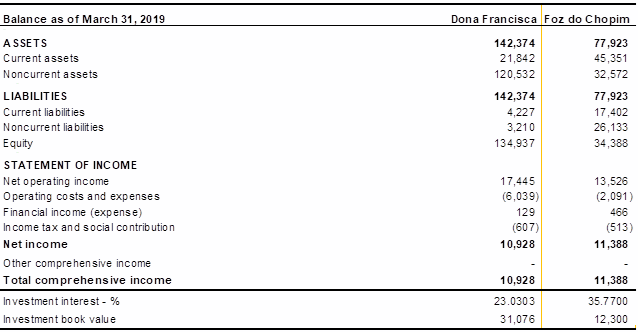
As of March 31, 2019, Copel's interest in the contingent liabilities of its associates is equivalent to R$61,634 (R$61,341 as of December 31, 2018).
18 Property, Plant and Equipment
18.1 Property, plant and equipment by assetclass

37
18.2 Changes in property, plant andequipment
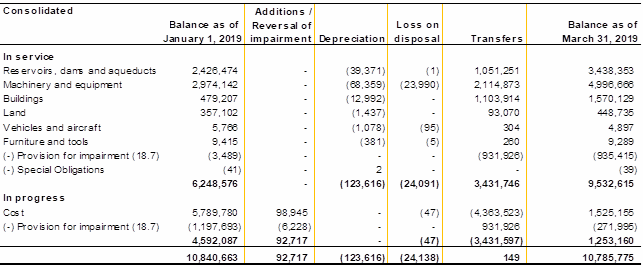
18.3 Costs of borrowings and debenturescapitalized
The costs of borrowings and debentures capitalized during the first quarter of 2019 amounted to R$1,169, at an average rate of 0.03% p.a. (R$1,297, at an average rate of 0.04% p.a. in the first quarter of 2018).
18.4 HPP Colíder
On March 9, 2019 and May 7, 2019, two generation units of the power plant started their commercial power generation operations, respectively, according to ANEEL Ordinance 673/2019 and 1,273/2019, both with installed power capacity of 100 MW. The third and last generation unit has scheduled start up of commercial power generation for the second half of 2019.
Due to acts of God and force majeure, the plant delayed the start-up of its commercial generation, initially scheduled for January 2015. Copel GeT submitted an application to ANEEL to exclude its responsibility, so that the obligation to supply energy could be postponed, which was not accepted by the agency. Copel GeT filed a common lawsuit with the Court on December 18, 2017 applying for a preliminary injunction and requesting the reversal of the decision of the Agency. On April 6, 2018, the Federal Court of the 1st Region fully granted the preliminary injunction required by Copel Get in the Interlocutory Appeal to exempt it from any burden, charges or restrictions to the right arising from the delay in the implementation schedule of the ColíderHPP.
After the beginning of partial commercial generation, in March 2019, the plant met its commitments under the power sale agreement with own generation of 41.1 MW mean, out of 125 MW mean contracted. For prior periods, Copel GeT has complied with its commitments of energy supply as follows:
· From January 2015 to May 2016 - with energy surpluses not contracted in its otherplants;
· In June 2016 - with partial reduction through a bilateral agreement;
38
· From July 2016 to December 2018, with reduction of all supply contracts of the CCEARs - Energy Trading Agreement in the Regulated Environment, through a bilateral agreement and participation in the New Energy and Decrease Clearing Facility (“Mecanismo de Compensação de Sobras e Déficits de Energia Nova - MCSD-EN”); and
· From January to March 2019, the firm contracts in the regulated environment became effective again, however, energy supply continued suspended in light of the injunction obtained by Management.
Since the trial on merits of the case is still outstanding, the contractual effects of both revenues and energy costs were recognized in profit or loss for the quarter for purposes of backing the outcome.
18.5 Joint operations - consortiums
The amounts recorded under property, plant and equipment referring to the share of interest of Copel GeT in consortiums are shown below:

18.5.1 Consórcio Empreendedor Baixo Iguaçu - Cebi
Copel holds a 30% interest in Consórcio Empreendedor Baixo Iguaçu – Cebi.The purpose of the consortium is to build and operate the project known as Baixo Iguaçu Hydroelectric Plant, with installed capacityof350.2MWand physical guarantee of 171.3MWmean located on the Iguaçu River between the municipalities of Capanema and Capitão Leônidas Marques, and between the Governador José Richa Hydroelectric Plant and the Iguaçu National Park, in the State of Paraná. The plant is now 100% in commercial operation, the start of commercial operation o funits 1 and 2 occurred in February 2019, and unit 3 occurred in April2019.
18.6 Cutia wind farm project
Cutia wind farm project, located in the State of Rio Grande do Norte, is divided into two large complexes:
· Cutia Complex: composed of seven wind farms (Guajiru, Jangada, Potiguar, Cutia, Maria Helena, Esperança do Nordeste and Paraíso do Ventos do Nordeste), with 180.6 MW of total installed capacity, and 71.4 MW-mean of assured power, All the wind farms are in commercial operation.
39
· Bento Miguel Complex: composed of six wind parks (São Bento do Norte I, São Bento do Norte II, São Bento do Norte III, São Miguel I, São Miguel II and São Miguel III) with total installed capacity of 132.3 MW and 58.7 MW-mean of assured power. All the wind farms are in commercial operation.
18.7 Estimated losses on impairment of generation segment assets
The projects with impairment balances recorded at March 31, 2019 are the following:

In the first quarter of 2019, the impairment changed as follows:

40
19 Intangible assets

19.1 Power distribution service concession

19.2 Generation concession agreements

19.3 Piped gas distribution service concession

19.4 Other intangible assets

41
20 Payroll, Social Charges and Accruals
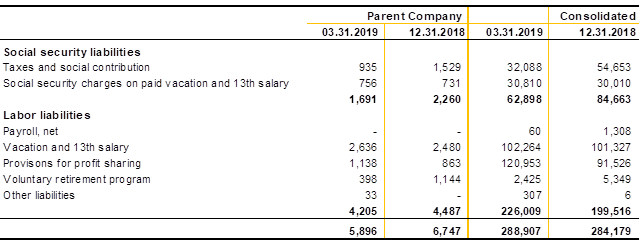
21 Accounts Payable to Suppliers

42
22 Borrowings

43

44
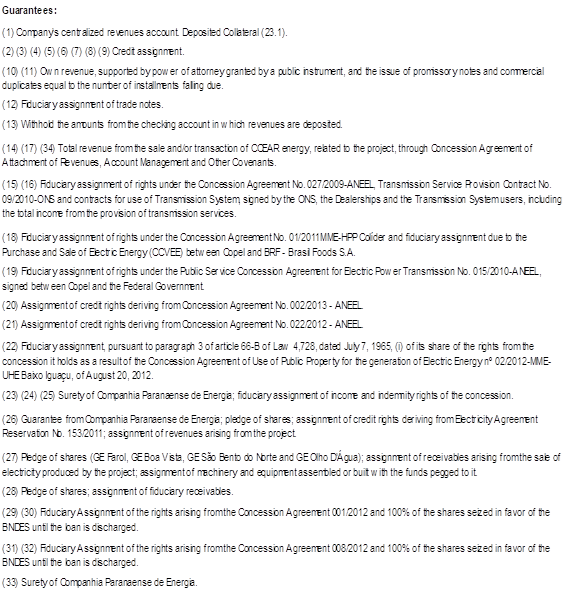
22.1 Collateral and escrow deposits - STN
These are guarantees provided in the form of cash deposits, Par Bonds ofR$53,034 (R$52,717 at December 31, 2018) and Discount Bonds in the amount of R$37,059 (R$36,838 at December 31, 2018), to be used to repay amounts of principal corresponding to STN contracts, when these payments are due on April 11, 2024. The amounts are updated by applying the weighted average percentage changes of United States Treasury Zero Coupon bond prices, by the share of each series of the instrument in the portfolio of collateral for principal, provided in the context of the Brazilian Financing Plan enacted in1992.
45
22.2 Breakdown of borrowings by currency and index

22.3 Maturity of non-current installments

22.4 Changes in borrowings


46
22.5 Covenants
The Company and its subsidiaries signed borrowings agreements containing covenants that require economic and financial ratios to be maintained within pre-determined parameters, requiring annual fulfillment and other conditions to be complied with, such as not changing the Company’s interest in the capital stock of subsidiaries that would represent change of control without prior consent.Failing to fufil these conditions may lead to accelerated debt repayment and/or fines.
As of December 31, 2018, the Company is in compliance with all covenants. As of March 31, 2019, Copel is in compliance with all other ratios and covenants.
The financial covenants contained in the borrowing’s agreements are presented below:

47
23 Debentures
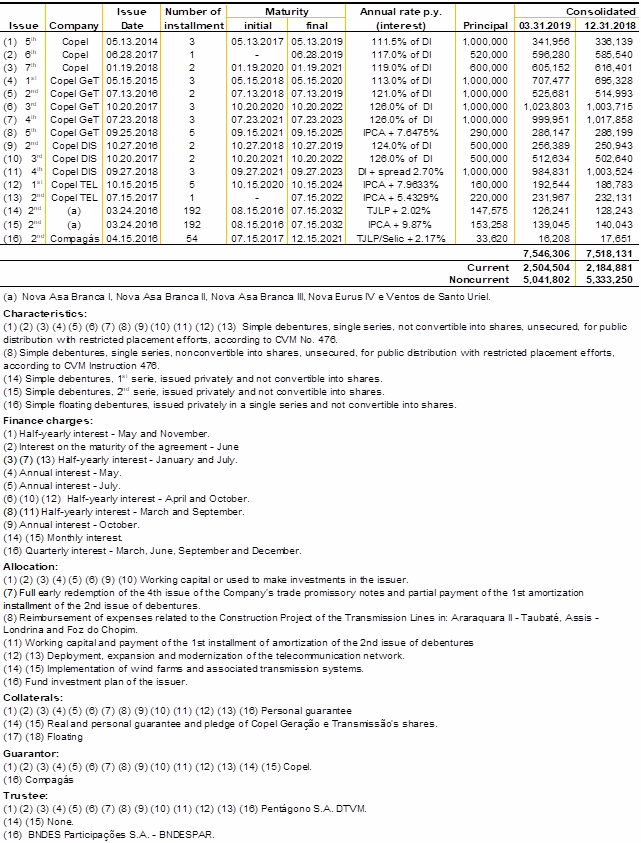
48
23.1 Maturity of non-current installments

23.2 Changes in debentures

23.3 Covenants
Copel and its subsidiaries issued debentures containing covenants that require the maintenance of certain economic and financial ratios within pre-determined parameters, requiring annual fulfillment and other conditions to be complied with, such as not changing the Company’s interest in the capital stock that would represent change of control without prior consent from the debenture holders; not paying out dividends or interest on capital if it is in arrears in relation to honoring any of its financial obligations or not maintaining the financial ratios as determined without prior written consent of the debenture holders. Failing to fulfill these conditions may lead to accelerated redemption of debentures and regulatory penalties.
As of December 31, 2018, subsidiaries Nova Asa Branca I Energias Renováveis S.A., Nova Asa Branca II Energias Renováveis S.A., Nova Asa Branca III Energias Renováveis S.A., Nova Eurus IV Energias Renováveis S.A. and Ventos de Santo Uriel did not comply with the Debt Service Coverage Ratio- ICSD of 1.3, when calculating the ratio without considering the amount of compensation to suppliers of goods (NE 32.6 – b to the financial statements at December 31, 2018). On December 28, 2018, the Company requested preventively and received a letter from BNDES, referring to AE/DEENE2 101/2018, not declaring accelerated maturity of the debentures in 2018. Except for the foregoing, as of December 31, 2018, the Company is in compliance with all covenants.
As of March 31, 2019, all the other ratios and covenants have been fulfilled.
49
The financial covenants contained in the debenture agreements are presented as follow:
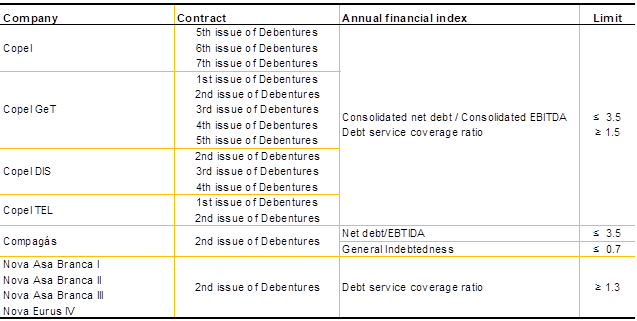
24 Post-employment Benefits
The Company and its subsidiaries sponsor private retirement and pension plans (Unified Plan and Plan III) and Healthcare Plan for medical and dental care (“ProSaúde II” and “ProSaúde III” Plans) for their active employees and their dependents. The lifetime sponsorship of the Healthcare Plan for retirees, pensioners and legal dependents is only applied to “Prosaúde II” plan participants.
24.1 Pension plan
The Unified Plan is a Defined Benefit plan - BD in which the income is predetermined, according to each individual’s salary. This plan has been a closed plan for new participants since 1998.
The Plan III is a Variable Contribution plan – CV, being the only plan available for new participants.
The costs assumed by the sponsors for these plans are recognized according to the actuarial evaluation prepared annually by independent actuaries in accordance with CPC 33 (R1) - Employee Benefits, corresponding to IAS 19 and IFRIC 14. The economic and financial assumptions for purposes of the actuarial valuation are discussed with the independent actuaries and approved by the Parent company’s Management.
24.2 Healthcare Plan
The Company and its subsidiaries allocate resources for the coverage of healthcare expenses incurred by their employees and their dependents, within rules, limits and conditions set in “ProSaúde II” and “ProSaúde III” Plans’ regulations. Coverage includes periodic medical exams in both plans and is only extended to all retirees and pensioners for life in the “ProSaúde II” plan.
50
24.3 Balance sheet and statement of income
Amounts recognized in liabilities, under Post-employment benefits, are summarized below:

Amounts recognized in the statement of income are shown below:

24.4 Changes in post-employment benefits

51
25 Sectorial ChargesDue

26 Research and Development and EnergyEfficiency
26.1 Balances recognized for investment in Research and Development (R&D) activities and the Energy Efficiency Program(EEP)
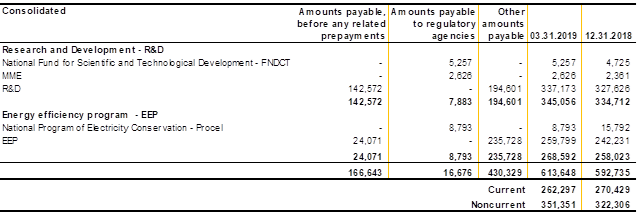
26.2 Changes in R&D and EEPbalances

52
27 Accounts Payable Related toConcessions

27.1 Changes in accounts payable related to concessions

28 Right-of-use asset and lease liability
With adoption of CPC 06 (R2)/IFRS 16, the Company recognized right-of-use asset and lease liability as follows:
28.1 Right-of-use asset

28.2 Lease liability
28.2.1 Changes in lease liability

The discount rate as of March 31, 2019 is 9.10% p.a.
53
28.2.2 Maturity of non-current installments

28.3 Commitments from leases and rentals
For leases of low value assets, such as computers, printers and mobile devices, short-term leases, as well as for leases of land for development of wind power generation projects, of which the payment is made based on variable remuneration, the amounts are recognized in the statement of income as operating costs and/or expenses (Note 33.6). The balance of commitments from leases and rentals is shown below:

29 Other Accounts Payable
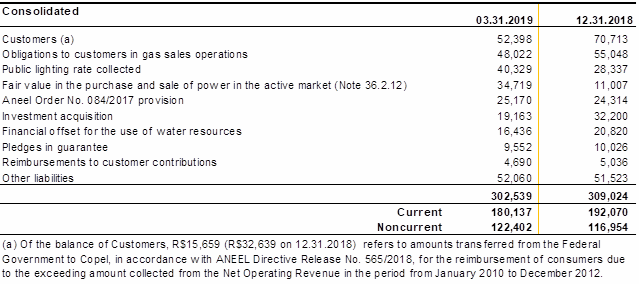
54
30 Provisions for Legal Claims and ContingentLiabilities
The Company and its subsidiaries are defendants in various judicial and administrative proceedings before different courts. Based on assessments made by the Company’s legal counsel, Management makes provisions for legal claims in which losses are rated probable, thus meeting the criteria for recognition of provisioning described in Note 4.11 to the financial statements at December 31, 2018.
The Company’s Management believes that it is not practicable to provide information regarding the expected timing of any cash outflows resulting from these lawsuits in which the Company and its subsidiaries are involved, due to the slow pace and unpredictability of Brazilian legal, tax and regulatory systems, and since final resolution of the proceedings for which a provision has been registered depends on the conclusions of court proceedings. Therefore, this information is not being provided.
30.1 Provision for legal claims
30.1.1 Changes in provision for legal claims rated as involving probable losses


30.1.2 Description of nature and/or details of the principallawsuits
a) Contribution for Social Security Funding(COFINS)
Plaintiff:Federal Revenue of Brazil
55
Cofins payables and respective interest and fines from August 1995 to December 1996 due to the termination of a judicial decision that had recognized the Company’s exemption fromCofins.
Current status:awaiting judgment.
b) Other tax provisions
Lawsuits relating to federal, state and municipal taxes, fees and other charges.
c) Labor
Labor claims comprise claims filed by employees and former employees of Copel and its subsidiaries in connection with the payment of overtime differences, hazardous working conditions, transfer bonuses, salary equality/reclassification and other matters, and also claims by former employees of contractors and third- parties (secondary responsibility) involving indemnity and other matters.
d) Employee benefits
Labor claims comprise claims filed by retired former employees of Copel and its wholly-owned subsidiaries against the Copel Foundation, which will have consequential impact on the Company and its wholly-owned subsidiaries, since additional contributions will be required.
e) Civil and administrative claims
Lawsuits involving billing, irregular procedures, administrative contracts and contractual fines, indemnity for accidents with the electric power network or vehicles.
The balance also contains amounts being discussed by arbitration under confidentiality, in the discovery phase, with no decision having been handed down to date.
The principal lawsuit is described below:
Plaintiff:Tradener Ltda. Estimated amount:R$132,047
Class lawsuit No. 588/2006 has already been rendered final and unappeasable, and the ruling recognized as valid the commissions payable by the Company to Tradener. In the civil public lawsuit No. 0000219- 78.2003.8.16.0004, filed by the Prosecution Office, a decision has also been rendered ruling on the absence of irregularities in the electric power purchase agreement. Therefore, Tradener brought recovery lawsuits, seeking to receive itscommissions.The appeal lodged by the Company has been dismissed.An application requesting clarification of decision has been filed.Awaiting judgment.
56
Current status:Case record 0005990.22.2012.8.16.0004 - the Company was ordered to pay the amount of R$107,955, the restated amount by reference to the INPC/IBGE variation, from the maturity of the commissions, plus interest of 1% per month, as from the date of notification (October 31, 2012), as well as attorneys’ fees. The Company filed an appeal against this decision, however, on November 8, 2016, by majority voting, the Court dismissed the appeal. Copel filed an application for Clarification of Ruling, which was partially granted for the ruling obscurity to be dispelled, although without changing the result of the appeal. Copel filed a Special Appea, which was dismissed.Copel filed an appeal to the Higher Court of Justice, which is pending judgment.
f) Easements
Lawsuits are filed challenging expropriation when there is a difference between the amount determined by Copel for payment and the amount claimed by the property owner and/or when the owner's documentation supporting title to the property may not be registered (when probate proceedings are still in progress, properties have no registry number with the land registry, etc.).
Cases may also arise from intervention in third-party adverse possession, either as a confronter, or in case of a property where there are areas of easement of passage, in order to preserve the limits and boundaries of expropriatedareas.
g) Expropriations and property
Lawsuits are filed challenging expropriation when there is a difference between the amount determined by Copel for payment and the amount claimed by the property owner and/or when the owner's documentation supporting title to the property may not be registered (in case probate proceedings are still in progress, properties have no registry number with the land registry, etc.).
Possessory lawsuits include those for repossession of property owned by the concession operator. Litigation arises when there is a need to repossess properties invaded or occupied by third parties in areas owned by the Company.Cases may also arise from intervention in third-party adverse possession, or owners or occupants of contiguous properties or even in cases of properties to preserve limits and boundaries of expropriated areas.
The main lawsuits are as follows:
| Plaintiff:property owner | Estimated value:R$40,470 |
Expropriation lawsuit for construction of electric substation discussing the indemnityamount.
Current status:lawsuit awaiting judgment at higher court.
| Plaintiff:property owner | Estimated value:R$9,459 |
Lawsuit for the expropriation of the area used for the reservoir of the Mauá Plant filed by Consórcio Energético Cruzeiro do Sul, in which Copel GeT participates with 51%, which discusses the indemnity amount of the property that is in a submergedpart.
57
Current status: Higher court decision, motions to clarify were filed, which have not yet been judged.After judgment of the motions to clarify, a special appeal will be filed seeking to reverse the decision.
h) Consumers
Lawsuits seeking compensation for damages caused in household appliances, industrial and commercial machines, lawsuits claiming damages for pain and suffering caused by service interruption and lawsuits filed by industrial consumers challenging the lawfulness of the increase in electricity prices while Plano Cruzado (anti-inflation economic plan) was in effect and claiming reimbursement for the amounts paid by the Company.
i) Environmental
Class lawsuits whose purpose is to obstruct the progress of environmental licensing for new projects or to recover permanent preservation areas located around the hydroelectric power plant dams unlawfully used by private individuals. If the outcome of the lawsuits is unfavorable to the Company, Management estimates only the cost to prepare new environmental studies and to recover the areas owned by CopelGeT. They also include the Commitment Agreements (TAC), which refer to the commitments agreed-upon and approved between the Company and the relevant bodies for noncompliance with any condition provided for by the Installation and Operating Licenses.
j) Regulatory
The Company is challenging, both at the administrative and judicial levels, notifications issued by the Regulatory Agency of alleged violations against regulations.The principal action is described below:
Plaintiffs:Companhia Estadual de Energia Elétrica - CEEE and Dona Francisca Energética S.A.
Estimated amount:R$53,120
Copel, Copel GeT and Copel DIS are challenging lawsuits filed against ANEEL's Decision 288/2002 involving these companies.
Current status:awaiting judgment.
30.2 Contingent liabilities
30.2.1 Classification of lawsuits rated as possible losses
Contingent liabilities are present obligations arising from past events for which no provisions are recognized because it is not probable that an outflow of resources embodying economic benefits will be required to settle the obligation. The following information concerns the nature of contingent liabilities of the Company and its subsidiaries and potential losses arisingtherefrom:
58

30.2.2 Description of nature and/or details of the principal lawsuits
a) Tax
Lawsuits relating to federal, state and municipal taxes, fees and other charges in which the Company challenges their applicability, calculation bases and amounts due to be collected.The main lawsuits are as follows:
| Plaintiff:National Institute of Social Security (INSS) | Estimated amount:R$106,420 |
Tax requirements related to the social securitycontribution.
Current status:awaiting judgment in the Administrative Council of Tax Appeals - CARF.
| Plaintiff: State TaxAuthority(SEFAZ) | Estimated amount: R$80,837 |
Copel Distribution received tax deficiency notice 6.587.156-4 from the State of Paraná for allegedly failing to pay ICMS (VAT) tax on the ‘metered demand’ line in the electricity bills issued to a major consumer between May 2011 and December 2013.
The Company maintains its illegitimacy to appear in the taxable position of this tax assessment, since it was not included in the judicial proceeding, thus it cannot suffer the effects of the ruling rendered thereon, which would entail its illegitimacy to appear as liable taxpayer in tax deficiency notice 6.587.156-4.
| Plaintiff:Copel | Estimated amount:R$79,422 |
Tax Requirement on Urban Territorial Property - IPTU on properties affected by the public electricity service. The case is pending judgment at first instance.
| Plaintiff: City | Estimated amount: R$57,547 |
City halls tax requirement as ISS on construction services provided by third parties.
Current status:awaiting the decision on the appeal.
| Plaintiff:Brazilian Federal Revenue Office | Estimated amount:R$109,630 |
Requirement and administrative questioning related to federal taxes, mostly still pending management review.
59
b) Labor
Labor claims comprise claims filed by employees and former employees of Copel and its subsidiaries in connection with the payment of overtime differences, hazardous working conditions, transfer bonuses, salary equality/reclassification, and other matters, and also claims by former employees of contractors and third- parties (secondary responsibility) involving indemnity and other matters.
c) Employee benefits
Labor claims comprise claims filed by retired former employees of the Company and its wholly-owned subsidiaries against the Copel Foundation, which will have consequential impact on the Company and its wholly-owned subsidiaries, since additional contributions will be required.
d) Civil
Lawsuits involving billing, irregular procedures, administrative contracts and contractual fines, indemnity for accidents with the electric power network or vehicles, easements of passage, expropriations, patrimonial and environmental.
The balance also contains amounts being discussed by arbitration under confidentiality, in the discovery phase, with no decision having been handed down to date.
The main lawsuits are as follows:
| Plaintiff:Mineradora Tibagiana Ltda. | Estimated amount:R$177,066 |
Lawsuit claiming compensation for alleged losses when this mining company was involvedinthe construction of the Mauá plant by the Energético Cruzeiro do Sul consortium in which Copel GeT has a 51% stake. The action challenges the validity of the mining permit granted by Mineradora Tibagiana for the Mauá job site and the indemnifying effects arisingtherefrom.
Current status:action awaiting judgment by lower court.
| Plaintiffs:franchises of the Agency/Copel store | Estimated amount:R$46,031 |
Filing of two individual claims against Copel Distribuição regarding the franchise contracts of the Agency/Copel store, with the main petition claiming an extension of the term of the contract and a secondary petition to recognize the existence of a sub concession, with transfer of the services provided and full pass-through of the fees, amongst other amounts, with related appeals currently awaiting trial.
Current status:awaiting judgment.
| Plaintiff: Copel Distribuição | Estimated amount: R$78,785 |
The Department of Roads and Roadworks - DER issued a tax assessment notice to Copel Distribuição, as a consequence, the Company filed a lawsuit challenging DER’s Charge for Use or Occupancy of Highway Domain Range, since the Company understands that this charge is unconstitutional because it has a confiscatory nature. Currently, the process awaits decision on the production of expert evidence.
60
e) Regulatory
The Company is challenging, both at the administrative and judicial levels, notifications issued by the Regulatory Agency of alleged violations against regulations. The principal action is described below:
| Plaintiff: Energia Sustentável do Brasil S.A. - ESBR | Estimated amount:R$729,609 |
ESBR filed Ordinary Lawsuit No. 10426-71.2013.4.01.4100 against ANEEL in the federal courts of Rondônia, the decision on which: (i) excludes liability for the 535-day schedule overrun in the construction of the Jirau Hydropower Station; (ii) declares any obligations, penalties and costs imposed on ESBR as a result of the schedule overrun to be unenforceable, and (iii) annuls ANEEL Resolution 1,732/2013, which recognized a schedule overrun of only 52 days. An appeal has been brought by ANEEL, pending judgment by the TRF of the 1stRegion.
The practical outcome of the decision is that, by exempting ESBR, it exposed the distribution utilities with which it had concluded regulated power trading contracts (CCEARs), including Copel DIS, to the spot market and spot prices during the period. The reason is that electricity trading rules require that all electricity consumed be covered by a contract.
If the lawsuits are judged unfavorably against Copel, the amount will be classified as Sectorial Financial Asset to be recovered through tariffrates.
Current status:awaiting judgment.
31 Equity
31.1 Capital
The paid-in share capital is R$7,910,000. The different classes of shares (with no par value) and the main shareholders are detailed below:

61
31.2 Equity valuation adjustments

31.3 Earnings per share – basic and diluted

62
32 Net Operating Revenue

63
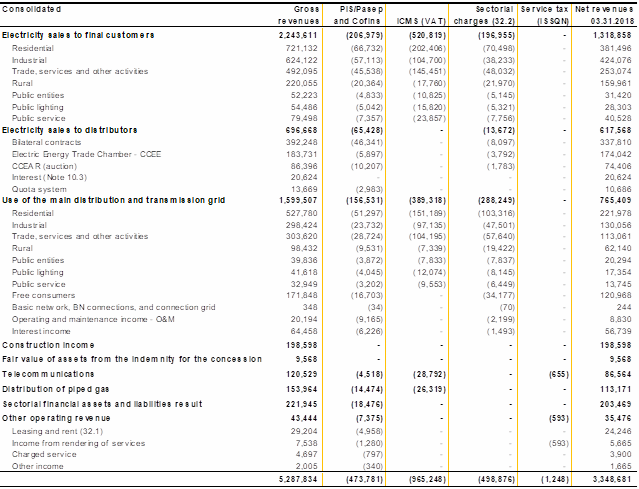
32.1 Leases and rentals
32.1.1 Revenues from leases and rentals

32.1.2 Receivables from leases

64
32.2 Regulatory charges

32.2.1 Energy Development Account – CDE
The CDE was created by Law 10,438/2002, amended by Law 12,783/2013 and, in order to meet its objectives, it has among its sources of funds, quotas paid by agents that negotiate energy with end consumers, in tariffs.
The Company makes payments for the “CDE USO” charge, intended to cover the CDE's objectives set forth by law, and the annual quota of “CDE ENERGIA”, composed of CONTA - ACR and CDE ENERGIA. In accordance with Resolution 2,510/2018, payment of the CDE ENERGIA quota has no longer been required since March 2019.
The annual quotas for each distributor are defined by ANEEL through resolutions enacted by it. The balance at March 31, 2019 is as follows:

Preliminary injunctions
As a result of preliminary injunctions in favor of the Brazilian Association of Large Industrial Consumers and Free Consumers - Abrace, and of the National Association of Energy Consumers - Anace and other associates, which challenge at court the tariff components of CDE-Use and CDE-Electricity, ANEEL, through Resolutions 1,967/2015, 1,986/2015 and 2,083/2016, ratified the tariff calculation, deducting these charges from associates of those entities, as long as the preliminary injunctions granted in Judicial Proceedings are not overthrown.
65
By Decree 1,576/2016, the associated distributors are assured of the right of non- transfer, deducting from the portion of CDE-Use and CDE-Electricity the amounts not collected. The unbilled amounts resulting from these injunctions do not impact the distributor's result.
32.3 Copel DIS annual tariff adjustment
ANEEL’s Resolution 2,402 of June 19, 2018, approved the result of Copel DIS Annual Tariff Review and authorized a 15.99% (5.85% in 2017) average rate increase to consumers, consisting of: 6.52% related to the inclusion of financial components; 0.31% from updating Portion B; 7.49% from adjusting Portion A; and 1.67% reflecting the withdrawal of the financial components from the previous tariffprocess.
This adjustment was fully applied to Copel DIS tariffs as from June 24, 2018.
33 Operating Costs and Expenses


66


33.1 Electricity purchased for resale

67
33.2 Personnel and management

33.3 Third party services

33.4 Credit losses, provisions and reversals

33.5 Construction costs

68
33.6 Other operating costs and expenses, net

34 Financial Results

34.1 Recognition of tax credit
On February 14, 2018, the Federal Revenue of Brazil recognized tax credit for the restated amount of R$80,225 in favor of the Company, regarding the disputed tax levy on Pasep from July 1988 to July 1995, in connection with the effects of Federal Senate Resolution 49, of October 9, 1995, which suspended the effects of Decree-Laws 2,445/1988 and 2,449/1988, deemed to be unconstitutional by the Federal Supreme Court. From the total amount recognized, R$55,096 were recorded in financial income and R$25,129 in other operatingincome.
69
35 Operating Segments
Operating segments are business activities that generate revenues and incur expenses, whose operating results are regularly reviewed by the executive boards of the Parent Company and subsidiaries and by key strategic decision-makers responsible for allocating funds and assessing performance.
35.1 Products and services from which we generate revenues from the reportable segments
The Company operates in reportable segments identified by Management, through the chief officers of each business area, taking into consideration the regulatory environments, the strategic business units and the different products and services. These segments are managed separately, since each business and each company requires different technologies and strategies.
In the first quarter of 2019, all sales have been to customers within the Brazilian territory, in addition, all non-current assets are also located in the national territory.
The Company and its subsidiaries did not identify any customer who individually accounts for more than 10% of their total net revenues in the first quarter of 2019.
The Company evaluates the performance of each segment based on information derived from the accountingrecords.
The accounting policies of the operating segments are the same as those described in Note 4.
35.2 The Company’s reportablesegments
The reportable segments of the Company, in accordance with CPC 22/IFRS 8, are:
Power generation and transmission (GET)- this segment comprises the generation of electric energy from hydraulic, wind, and thermal projects(GER)and the transmission and transformation of the power generated by the Company, and the construction, operation and maintenance of all power transmission substations and lines(TRA); for managers, the assets and liabilities of the generation and transmission segments are shown on an aggregate basis while their result is shown separately;
Power distribution (DIS)- this segment comprises the distribution of electric energy, the operation and maintenance of the distribution infrastructure and related services;
Telecommunications (TEL)- this segment comprises telecommunications and general communication services;
GAS- this segment comprises the public service of piped natural gas distribution;
Power sale (COM)- this segment comprises the sale of electric energy and related services; and
Holding Company (HOL)- this segment comprises participation in other companies.
70
35.3 Assets by reportable segment

35.4 Statement of income by reportable segment
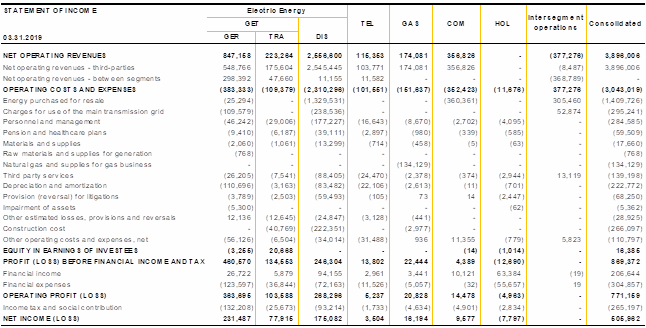
71
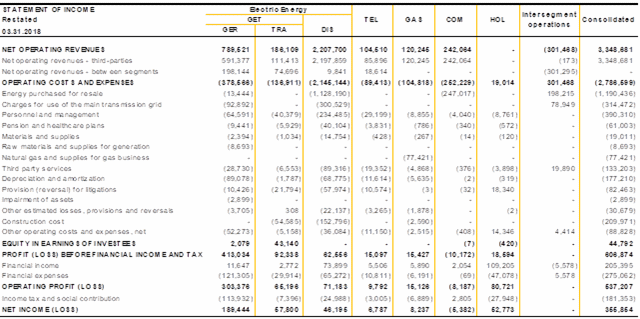
35.5 Additions to non-current assets by reportablesegment

72
36 Financial Instruments
36.1 Categories and determination of fair value of financialinstruments
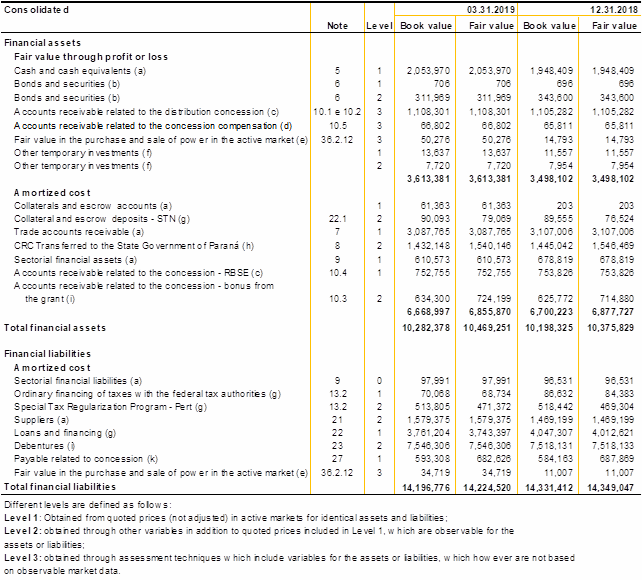
Determining fair values
a) Equivalent to their respective carrying values due to their nature and terms ofrealization.
b) Fair value is calculated based on informationmadeavailable by the financial agents and the market values of the bonds issued by the Braziliangovernment
c) The criteria are disclosed in Note4.4 to the financial statements at December 31, 2018.
d) The fair values of generation assets approximate their carrying amounts, according to Note4.4 to the financial statements at December 31, 2018.
e) The fair values of assets and liabilities are equivalent to their carrying amounts according to Note 36.2.12.
73
f) Calculated according to the price quotations published in an active market, for assets classified as level 1 and determined in view of the comparative assessment model for assets classified as level2.
g) The cost of the last borrowing taken out by the Company is usedasa basic assumption, namely TJLP plus spread of 1.94% p.a., for discount of the expected paymentflows.
h) The Company based its calculation on the comparison with a long-term and post-fixed National Treasury Bond (NTN-B) maturing on August 15, 2024, which yields approximately 4.04% p.a. plus the IPCA inflation index.
i) Receivables related to the concession agreement for providing electricity generation services under quota arrangements at their fair value calculated by expected cash inflows discounted at therateestablished in ANEEL auction notice 12/2015(9.04%).
j) Calculated from the Unit Price quotation (PU) for March 31, 2019, obtained from the Brazilian Association of Financial and Capital Markets (ANBIMA), net of unamortized financialcost.
k) Actual net discount rate of 8.13% p.a., in line with the Company’s estimated rate for long-termprojects.
36.2 Financial risk management
The Company's business activities are exposed to the following risks arising from financial instruments:
36.2.1 Credit risk
Credit risk is the risk of the Company incurring losses due to a customer or financial instrument counterparty, resulting from failure in complying with contractual obligations.

a) The Company’s Management manages the credit risk of its assets in accordance with the Group's policy of investing virtually all of its funds in federal banking institutions. As a result of legal and/or regulatory requirements, in exceptional circumstances the Company may invest funds in prime privatebanks.
74
b) The risk arises from the possibility that the Company might incur losses resulting from difficulties to receive its billings to customers. This risk is closely related to internal and external factors of Copel. To mitigate this type of risk, the Company manages its accounts receivable, detecting defaulting consumers, implementing specific collection policies and suspending the supply and/or recording of energy and the provision of service, as established in theagreement.
c) Management believes this credit risk is low because repayments are secured by funds fromdividends.
d) Management believes this risk is low because these contracts assure an unconditional right to be paid in cash by the Concession Grantor at the end of the concession period for any infrastructure investments not recovered throughtariffs.
e) Management considers the risk of this credit to be reduced, since the agreements signed guarantee the unconditional right to receive cash at the end of the concession to be paid by the Concession Grantor, referring to investments in infrastructure not recovered through thetariff.
Management also considers the credit risk reduced to the balance of RBSE assets, even in light of the injunctions that temporarily reduced the RAP to be received, as described in Note 10.4.
f) Management considers the risk of this credit to be low, as the contract for the sale of energy by quota guarantees the receipt of an Annual Generation Revenue - RAG guaranteed which includes the annual amortization of this amount during the concessionterm.
g) For the generation concession assets, ANEEL published Normative Resolution 596/2013, which deals with the definition of criteria for calculating the VNR, for the purposes of indemnification. Management's expectation regarding the indemnification of these assets indicates the recoverability of the balances recorded, as described in Note 10.5.
h) This risk arises from the possibility that the Company might incur losses resulting from the volatility on the stock market. This type of risk involves external factors and has been managed through periodic assessment of the variations occurred in themarket.
36.2.2 Liquidity risk
The Company's liquidity risk consists of the possibility of having insufficient funds, cash or other financial assets to settle obligations on their scheduled maturity dates.
The Company manages liquidity risk relying on a set of methodologies, procedures and instruments applied to secure ongoing control over financial processes to ensure proper management of risks.
Investments are financed by incurring medium and long-term debt with financial institutions and capital markets.
Short, medium and long-term business projections are made and submitted to Management bodies for evaluation. The budget for the next fiscal year is annually approved.
Medium and long-term business projections cover monthly periods over the next five years. Short-term projections consider daily periods covering only the next 90 days.
75
The Company permanently monitors the volume of funds to be settled by controlling cash flows to reduce funding costs, the risk involved in the renewal of loan agreements and compliance with the financial investment policy, while concurrently keeping minimum cash levels.
The following table shows the expected undiscounted settlement amounts in each time range. Projections were based on financial indicators linked to the related financial instruments and forecast according to average market expectations as disclosed in the Central Bank of Brazil's Focus Report, which provides the average expectations of market analysts for these indicators for the current year and the following year. As from 2022, 2021 indicators are repeated on an unaltered basis throughout the forecast period.

As disclosed in Notes 22.5 and 23.3, the Company and its subsidiaries have borrowings agreements and debentures with covenants that if breached may have their payment accelerated.
At March 31, 2019, the Company recorded negative net working capital of R$741,834 (R$265,568 at December 31, 2018) in the Parent company and R$86,075 (R$17,268 at December 31, 2018) in the Consolidated. Management has been monitoring the liquidity and taking actions to balance the short-term financial capacity, preserving the Company's investment programs, as well as seeking debt repayment extension. An example of this borrowing is presented in Note 41.3.
36.2.3 Market risk
Market risk is the risk that the fair value or the future cash flows of a financial instrument shall oscillate due to changes in market prices, such as currency rates, interest rates and stock price. The purpose of managing this risk is to control exposures within acceptable limits, while optimizing return.
a) Foreign currency risk (US Dollar)
This risk comprises the possibility of losses due to fluctuations in foreign exchange rates, which may reduce assets or increase liabilities denominated in foreign currencies.
The Company’s foreign currency indebtedness is not significant and it is not exposed to foreign exchange derivatives. The Company monitors all relevant foreign exchangerates.
The effect of the exchange rate variation resulting from the power purchase agreement with Eletrobras (Itaipu) is transferred to customers in Copel DIS's next tariffadjustment.
76
The exchange rate risk posed by the purchase of gas arises from the possibility of Compagás reporting losses on the fluctuations in foreign exchange rates, increasing the amount in Reais of the accounts payable related to the gas acquired from Petrobras. This risk is mitigated by the monitoring and transfer of the price fluctuation through tariff, when possible. Compagás monitors these fluctuations on an ongoing basis.
Sensitivity analysis of foreign currency risk
The Company has developed a sensitivity analysis in order to measure the impact of the devaluation of the US dollar on its borrowings subject to currency risk.
The baseline scenario takes into account the existing balances in each account as of March 31, 2019and the probable scenario assumes a variation in the foreign exchange rate – prevailing at the end of the period (R$/USD 3.75) based on the median market expectation for 2019 reported in the CentralBank’sFocus report of April 26, 2019. For the scenarios 1 and 2, deteriorations of 25% and 50%, respectively, were considered for the main risk factor for the financial instrument compared to the rate used in the probable scenario.

In addition to the sensitivity analysis required by CVM Resolution 475/2008, the Company evaluates its financial instruments considering the possible effects on profit and loss and equity of the risks evaluated by the Company’s Management on the reporting date for the financial instruments, as recommended by CPC 40 (R1) - Financial Instruments: Disclosure. Based on the equity position and the notional value of the financial instruments held as of March 31, 2019, it is estimated that these effects will approximate the amounts stated in the above table in the column for the forecast probable scenario, since the assumptions used by the Company are similar to those previouslydescribed.
b) Interest rate and monetary variation risk
This risk comprises the possibility of losses due to fluctuations in interest rates or other indicators, which may reduce financial income or financial expenses or increase the financial expenses related to the assets and liabilities raised in the market.
The Company has developed a sensitivity analysis in order to measure the impact of variable interest rates and monetary variations on its financial assets and liabilities subject to these risks.
77
Sensitivity analysis of interest rate and monetary variation risk
The Company has developed a sensitivity analysis in order to measure the impact of variable interest rates and monetary variations on its financial assets and liabilities subject to these risks.
The baseline scenario takes into account the existing balances in each account as of March 31, 2019 while the ‘probable’ scenario assumes balances reflecting varying indicators as follows: CDI/Selic - 6.50%, IPCA – 4.01%, IGP-DI – 5.83%, IGP-M – 5.58% and TLP - 6.10%, estimated as market average projections for 2019 according to the Focus Report issued by the Central Bank of Brazil asof April 26, 2019, except TLP that considers the Company’s internalprojection.
For the scenarios 1 and 2, deteriorations of 25% and 50%, respectively, were considered for the main risk factor for the financial instrument compared to the rate used in the probable scenario.

In addition to the sensitivity analysis required by CVM Resolution 475/2008, the Company evaluates its financial instruments considering the possible effects on profit and loss and equity of the risks evaluated by the Company’s Management on the reporting date for the financial instruments, as recommended by CPC 40(R1). Based on the equity position and the notional value of the financial instruments held as of March 31, 2019, it is estimated that these effects will approximate the amounts stated in the above table in the column for the forecast probable scenario, since the assumptions used by the Company are similar to those previouslydescribed.
78
36.2.4 Electricity shortage risk
Approximately 64% of installed capacity in Brazil currently comes from hydroelectric generation, as informed by the Generation Information Bank of ANEEL, which makes Brazil and the geographic region in which we operate subject to hydrological conditions that are unpredictable, due to non-cyclical deviations of mean precipitation. Unsatisfactory hydrological conditions may cause, among other things, the implementation of comprehensive programs of electricity savings, such as rationalization or even a mandatory reduction of consumption, which is the case of rationing.
Since 2014, the reservoirs of the Southeast/Midwest, North and Northeast Brazilian regions have been subject to adverse climate situations, leading agencies responsible for this industry to adopt water resources optimization measures to guarantee fully meeting electricitydemand.
The Electric Sector Monitoring Committee (CMSE) has maintained the energy deficit risk indicators within the safety margin in short-term projections. The same position is adopted by ONS regarding the risk of deficit in the medium term, as stated in the 2018-2022 Energy OperationPlan – PEN 2018.
Although dam storage levels are not ideal, from the standpoint of regulatory agencies, when combined with other variables, they are sufficient to keep the risk of deficit within the safety margin established by the National Energy Policy Council - CNPE (maximum risk of 5%) in all subsystems.
36.2.5 Risk of GSF impacts
The Energy Reallocation Mechanism (MRE) is a system of redistribution of electricpowergenerated, characteristic of the Brazilian electric sector, which has its existence by the understanding, at the time, of the need for a centralized operation associated with a centrally calculated optimal price known as PLD. Since generators have no control over their production, each plant receives a certain amount of virtual energy which can be compromised through contracts. This value, which enables the registration of bilateral contracts, is known as Physical Guarantee - GF and is also calculated centrally. Unlike PLD, which is calculated on a weekly basis, GF, as required by Law, is recalculated every five years, with a limit of increase or decrease, restricted to 5% by revision or 10% in the concessionperiod.
The contracts need to have an energy physical guarantee basis. This is done, especially, through the allocation of power generated received from the MRE or purchase. The GSF is the ratio of the entire hydroelectric generation of the MRE participants to the GF sum of all the MRE plants. Basically, the GSF is used to calculate how much each plant will receive from generation to back up its GF. Thus, knowing the GSF of a given month the company will be able to know if it will need to back up its contracts through purchases.
Whenever GSF multiplied by GF is less than the sum of contracts, the company will need to buy the difference in the spot market. However, whenever GSF multiplied by GF is greater than the total contracts, the company will receive the difference to the PLD.
79
The low inflows that have been recorded since 2014, as well as problems with delays in the expansion of the transmission system have resulted in low GSF values, resulting in heavy losses for the companies holding MRE participating hydroelectric projects.
For plants with contracts in the Free Contracting Environment - ACL, the main way to manage the low GSF risk is not to compromise the entire GF with contracts, approach currently adopted by the Company.
For the contracts in the ACR, Law 13,203/2015 allowed the generators to contract insurance for electricity demand (load), by means of payment of a risk premium. Copel adopted this approach to protect contracts related to energy generated by the Mauá, Santa Clara, Fundão, Baixo Iguaçu and Colíder Thermoelectric Plants and Cavernoso II Small HPP.
For the distribution segment, the effects of the GSF are perceived in the costs associated with quotas of Itaipu, of Angra and the plants whose concessions were renewed in accordance with Law 12,783/2013, as well as in the costs of the contracts for power availability with thermoelectric plants. This is a financial risk, since there is guarantee of neutrality of expenses with energy purchases through a tariff transfer.
36.2.6 Risk of non-renewal of concessions - generation andtransmission
Currently, the extension of generation, transmission and distribution concessions covered by Articles 17, 19 and 22 and Law 9,074/1995, is regulated by Law 12,783/2013. Decree 9,187 of November 1, 2017 regulates the extension of the thermoelectric power generation concessions set forth in said Law.
Concessions of hydroelectric power generation, electric power transmission and distribution may be extended at the discretion of the Concession Grantor, one single time, for a period of up to 30 years. However, for concessions of thermoelectric power generation, extension period is limited to 20 years.
The concession operator should request extension of concession at least 60 months before the final contract date or after granting of concessions to hydroelectric power generation and electric power transmission and distribution plants, and of up to 24 months for thermoelectric plants. The Concession Grantor may advance effects of extension by up to 60 months counted as of contract or grant date, and may also define initial tariff or revenue.
By 2023, only Governor Bento Munhoz da Rocha Netto hydroelectric power plant (1676 MW) will have its concession expired. The Company did not express an interest in extending this concession. Under Law 12,783/2013, the option for extension is conditioned to a change in the plant operation regime, which may occur within 60 months before its final term. Internal studies have shown that the extension through change of the anticipated operation regime is economically and financially disadvantageous in relation to the exploration of the plant in the present regime until its final term. The plant must be tendered by the Concession Grantor and the Company may participate in the auction, if it meets the qualification conditions.
Regarding the Figueira HPP concession, expired in March 2019, the Company awaits the conclusion of the related ANEEL procedural steps to execute the Amendment to the Concession Agreement. The plant is undergoing a modernization process and will have as direct benefits the improvement in energy efficiency and the reduction of pollutant emissions in the atmosphere, in comparison with the old plant.
80
According to the law, the Company may express its intention to extend the concession of the São Jorge HPP in 2019, the Apucaraninha HPP in 2020, and the Guaricana and Chaminé HPPs in 2021. If the Company does not express an interest in the extension of the current regime, the concession of the São Jorge HPP may, at its final term, be granted to the Company in the condition of registration, and the other concessions, at their final term, shall be tendered by the Concession Grantor.
Copel GeT does not have any transmission concession ending in the next ten years.
36.2.7 Risk on non-renewal of concessions - distribution of electricity
On December 9, 2015, pursuant to the fifth Concession Agreement Amendment No. 46/1999 of Copel DIS, the concession was extended, provided that quality and efficiency parameters for provision of distribution services are met, measured by indicators that consider duration and frequency of service interruptions (DECi and FECi) and efficiency in the Company’s economic and financial management.
The fifth amendment to the concession agreement imposes indexes of economic and financial efficiency and quality. Failure to comply with the indexes for two consecutive years or any limits at the end of the first five years will result in the termination of the concession (clause 18, sub clause 1), observing the agreement terms, specifically the right to full defense and reconsideration.
Non-compliance with the annual global electricity supply quality indicators (DEC and FEC) for two consecutive years or three times in five years, depending on ANEEL’s regulation, may limit the payment of dividends or interest on capital (clause 2, sub clause 8), while the breach of the economic and financial sustainability indicators may require a capital contribution from the controlling shareholders (clause 13, sub clause 4) within up to180 days from the end of each fiscal year, of the total insufficient amount to meet the Minimum Economic and Financial Sustainability Parameter provided for in clause 7.
From the sixth year following the signing of the agreement, the breach of quality criteria for three consecutive years or of economic and financial management criteria for two consecutive years will result in the opening of an expiration proceeding (clause 12, sub clause 14), causing the end of the concession.
The following table sets forth the minimum parameters of economic and financial sustainability defined for Copel DIS in the first five years of the renewal:
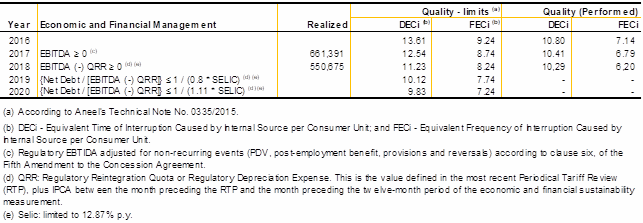
81
36.2.8 Risk of non-extension of the gas distributionconcession
As presented in Note 2.1.1, the expiration date of the gas distribution concession of the subsidiary Compagás is under discussion with the concession grantor.
In the event of non-extension of the concession, Compagás will be entitled to compensation for investments made in the last 10 years prior to the end of the concession at their depreciated replacement value, according to the contractualclause.
36.2.9 Risk of overcontracting and undercontracting ofelectricity
Under the current regulatory model, the agreement for purchase of electric power by distributors is regulated by Law 10,484/2014 and Decree 5,163/2004, which determine that distributors must purchase the volume required to serve 100% of their market.
The contracting of the total output available in the market is verified by observing the period comprising the calendar year, and the difference between the costs remunerated by the tariff and those actually incurred in the power purchases are fully passed on to captive consumers, as long as the Distributor presents a contracting level between 100% and 105% of its market. However, if distributors determine contracting levels lower or higher than the regulatory limits, there is the assurance of neutrality if it is identified that such violation derives from extraordinary and unforeseen events that are not manageable by the buyer.
Since 2016, the distribution segment has been exposed to a general overcontracting scenario, as most companies determined contracting levels higher than 105%. Considering that several factors that have contributed to this situation are extraordinary and unavoidable by the distributors, such as the involuntary allocation of physical guarantee quotas and the broad migration of consumers to the free market, ANEEL and MME implemented a series of measures aiming at the mitigation of overcontracting.
In relation to the contracting of 2019, the scenarios of supply and demand indicate the possibility of occurrence of overcontracting due to consumers migration to the free market. This is the main risk factor involving exposure to overcontracting, which entitles recognition of involuntary overcontracting.
36.2.10 Gas shortage risk
This risk involves potential periods of shortage of natural gas supply to meet the Company’s gas distribution and thermal generation business requirements. Long periods of gas shortage could result in losses due to lower revenues by subsidiaries Compagás and UEG Araucária.
The natural gas supply contract between Brazil and Bolivia is effective for twenty years, ending in 2019. Due to the non-use of all contracted natural gas in recent years, the Ministry of Mines and Energy considers the extension of the term of this contract by two years in its Ten Year Planning. In the event of non-renewal of this contract, currently centralized in Petrobras, direct consumers or state distributors must directly negotiate the fuel supply with producers, importers or suppliers of natural gas.
On the other hand, the volume of natural gas produced in the pre-salt has increased. The Brazilian’s output in 2018 was 111.94 million m³/day and with growing trend.
82
In addition to the gas from Bolivia and from the pre-salt, there is the alternative of importing Liquified Natural Gas (LNG).
There are also projects of new regasification stations in all Brazilian regions, with stations located in the South region of Brazil capable of serving the consumption of this region of the country without the need for large investments in transport infrastructure and reducing the level of capacity utilization of the Gasbol Sul line, which would increase the supply of natural gas in Paraná.
In the international market, the natural gas price has remained stable, indicating a balance between supply and demand.
In this scenario, the natural gas shortage risk can be considered low.
36.2.11 Risk of non-performance of wind farms
The power generation authorization contracts for wind power are subject to performance clauses, which provide for a minimum annual and four-year generation of the physical guarantee committed in the auction. Ventures are subject to climatic factors associated with wind velocity uncertainties, and non-compliance with what is stated in the agreement may jeopardize future revenues of the Company. At March 31, 2019, the consolidated balance of the provision recorded in liabilities referring to the non-performance is R$61,399 (R$83,525 at December 31, 2018), which may be offset by higher future production, measured within the annual and/or four-yearly contractual cycle.
36.2.12 Risk related to price of power purchase and sale transactions in the activemarket
The Company operates in the market for the purchase and sale of energy in the active market (Note 4.15 to the financial statements at December 31, 2018), with the objective of achieving results with changes in energy prices, subject to the risk limits established by Management. This activity, therefore, exposes the Company to the risk of future energy price.
The purchase and sale of energy are recognized at fair value through profit or loss, based on the difference between the contracted price and the market price of the transactions at the balance sheet date.
Based on the notional value of R$232,911 for purchase contracts and R$142,838 for contracts for the sale of electricity, outstanding on March 31, 2019, the fair value was estimated using the prices defined by the Company in the last week of March 2019, which represented the best estimate of the future market price. The discount rate uses the return rate of the NTN-B disclosed by ANBIMA as of March 29, 2019, adjusted by a credit risk rate.
The balances relating to these outstanding transactions at March 31, 2019 are presented below:

83
Sensitivity analysis on the power purchase and sale transactions in the active market
The main risk factor is the exposure to variation of energy market prices. The variation of the discount rate does not have a relevant impact on the fair value determined, especially in view of the short-term for the settlement of contracts.
The sensitivity analyses were prepared in accordance with CVM Instruction 475/08, considering, for scenarios 1 and 2, the increase or decrease of 25% and 50% in future prices, applied to market prices of March 31, 2019. The results obtained are as follows:

36.2.13 Counterparty risk in the energy market
Since free energy market still does not have a counterparty acting as guarantor of all agreements (clearing house), there is a bilateral risk of default. Thus, the Company is exposed to the risk of failure in the supply of energy contracted by the seller. In the event of such failure, the Company must buy energy at the spot market price, being further subject to regulatory penalties and loss of amounts paid.
The Company follows a policy that establishes limits for possible operations with each counterparty, after analyzing its credit worthiness, maturity and history.
In addition, even if our policy is more restrictive, and the counterparties present good financial condition, the Company is exposed to systemic events in which the default of one agent ends up affecting other energy trading companies in a "domino effect" until reaching the Company's counterparties.
36.3 Capital management
The Company seeks to keep a strong capital base to maintain the trust of investors, creditors and market and ensure the future development of the business. Management also strives to maintain a balance between the highest possible returns with more adequate levels of borrowings and the advantages and the assurance afforded by a healthy capital position. Thus, it maximizes the return for all stakeholders in its operations, optimizing the balance of debts and equity.
The Company monitors capital by using an index represented by adjusted consolidated net debt divided by adjusted consolidated EBITDA (Earnings before interest, taxes, depreciation and amortization), for the last twelve months. The corporate goal established in the strategic planning provides for maintenance of ratio below 3.5 while any expectation of failing to meet this target will prompt Management to take steps to correct its course by the end of each reporting period.
84
36.3.1 The equity to debt ratio is shown below:

37 Related Party Transactions

85
a) The Luz Fraterna Program, created under Law 491/2013 and 17,639/2013 allows the State Government to pay for the electricity bills of low income families in Paraná, which have duly applied for the program and provided that their consumption does not exceed 120kWhper month. This benefit is available to residential customers with single-phase connections, rural customers with single- phase connections or two-phase connections with circuit breakers of up to 50 amperes. Applicants must not have more than one electricity bill under their names and must not have any pending debts to the Company.
In March 2018, the amount of R$159,274 was settled. The principal interest, fine and monetary restatement, at December 31, 2011, totaled R$158,849. For these charges on electricity bills for the period of September 2010 to June 2015, a lawsuit was filed against the State of Paraná on November 5, 2018, relating to the payment of invoices pursuant to State Law 14,087/2003. We highlight that despite the negotiations maintained by Management, seeking to settle this debt, uncertainties still exist regarding the realization of this asset and therefore, in view of this condition, this asset was not recognized, therefore, in accordance with the current accounting standards. For the tax treatment, as determined by the Federal Revenue of Brazil in the Normative Instruction 1,753/2017, the Company has taxed this revenue.
The Morar Bem Paraná Program, established by Decree 2,845/2011, introduced an agreement between the Paraná State, Companhia de Habitação do Paraná (Cohapar) and Copel, and is managed by Cohapar. Copel main attribution under this agreement is the construction of energy distribution grids and housing project consumer unit service connections.
Management further emphasizes that it is making all necessary efforts and taking all necessary measures to preserve the Company’s interests.
b) Reimbursement of wages and social charges for employees transferred to the Paraná State Government. Balances presented are net of expected credit loss.
c) Revenue of Copel TEL from telecommunications services and lease of equipment andinfrastructure.
d) The Meteorological System of Paraná - Simepar is a supplementary unit of the Independent Social Service Paraná Technology, linked to the State Department of Science, Technology and Higher Education. Simepar had contracts with Copel for services of weather forecast, meteorological reports, ampacity analysis, mapping and analyses of winds and atmosphericdischarges.
e) BNDES is the parent company of BNDES Participações S.A.- BNDESPAR, which owns Copel shares (Note 31.1). On December 22, 2018, the shareholder agreement between the State of Paraná and BNDESPAR, signed on December 22,1998, was ended.
f) BNDES and BNDESPAR acquired all the debentures issued by the subsidiaries Nova Asa Branca I, Nova Asa Branca II, Nova Asa Branca III, Nova Eurus IV and Ventos de Santo Uriel (Note23).
g) Basic sanitation provided bySanepar.
h) Charges for the use of the Transmission System and revenue from operating and maintenance contracts, engineering services and sharing of facilities with CopelGeT and UEGA.
86
i) Copel DIS has Contracts for Connecting to the Transmission System - CCT with Caiuá Transmissora de Energia, with expiration until the concession of the distributor or transmitter expires, whichever occurs first.
j) Copel DIS maintains a Contract for the Use of Transmission System (Cust) with ONS and power transmission concession operators whose subject matter is the contracting of Transmission System Use Amount (Must). Contracting is permanent and is regulated by ANEEL Normative Resolution 666/2015. Amounts are defined for four subsequent years, with annualreviews.
k) Power purchase and sale agreement signed by Dona Francisca Energética and Copel GeT, expiring on March 31,2025.
l) Light pole sharing agreement, signed between Sercomtel S.A.Telecomunicações and Copel DIS.
m) The Institute of Technology for Development (Lactec) is a Public Interest Civil Society Organization (OSCIP), in which Copel is an associate. Lactec has service and R&D contracts with Copel GeT, UEGA and Copel DIS, which are subject to prior or later control and approval byANEEL.
Transactions arising from operations in a regulated environment are billed according to the criteria and definitions established by the regulatory agents.
37.1 Guarantees awarded to related parties
Sureties and guarantees granted by Copel to its subsidiaries for financing and debentures are informed in Notes 22 and 23.
Copel provided financial guarantees, in the form of corporate guarantee letter, for power purchase agreements made by Copel GeT, in the total amount of R$3,534 (R$3,246 at December 31, 2018) and made by Copel Energia, in the amount of R$76,358 (R$79,358 at December 31, 2018).
Sureties and guarantees granted by Copel and Copel GeT for financing, debentures and insurance contracts of joint ventures are shown below:
87


38 Commitments
Commitments related to long-term contracts not yet incurred, and therefore not recognized in the financial statements, are as follows:

88
39 Insurance
Details by peril type and effective date of the main insurance policies can be seen below:
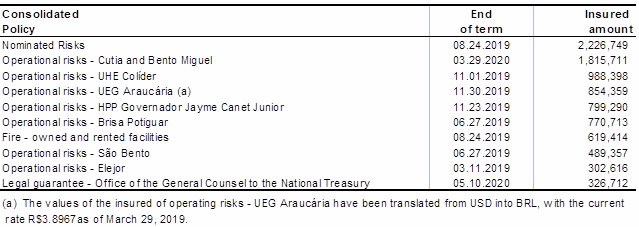
In addition to the insurance policies listed above, the Company and its subsidiaries take out other insurance policies with lower values, such as: for liability of Directors and Officers (D&O), general civil liability, payment guarantee, sundry perils, national and international transportation, life, aircraft and vehicles. The guarantee insurance taken out by the subsidiaries, joint ventures and associates have Copel and/or Copel GeT as guarantor, within the limits of their share of interest in each project.
40 Additional information to the Statement of CashFlows
40.1 Transactions not involving cash
Among the transactions carried out in the line item Contract assets, specified in Notes 11.1 and 11.2, the acquisitions totaled R$232,811 (R$135,109 at December 31, 2018). Of this amount, R$57,124 (R$31,970 at December 31, 2018) represent the amount of purchases made in installments and not settled through the end of the reporting period.
According to information in Note 18.2, property, plant and equipment acquisitions totaled R$98,945 (R$425,260 at March 31, 2018). Of this amount, R$45,414 (R$45,261 at March 31, 2018) represent the amount of purchases made in installments and not settled through the end of the reporting period.
In December 2018, there was acquisition in installments of the studies and projects denominated PCH Bela Vista and UHE Salto Grande, for the amount of R$19,461, with the company Foz do Chopim Energética Ltda, such liability being recorded in accounts payable to suppliers. In the first quarter of 2019, there was partial settlement of the aforementioned negotiation, in the amount of R$13,235, through a matching of accounts with the dividends receivable from that supplier, which is part of the Company's consolidated investments as associate.
The mentioned transactions did not involve cash and, for this reason, are not being presented in the statement of cash flows.
89
41 Subsequent events
41.1 Mata de Santa Genebra Transmissão S.A.
On April 22, 2019, Mata de Santa Genebra Transmissão S.A. concluded the issue of simple non-convertible debentures, in accordance with Law 12,431 of June 24, 2011 ("Infrastructure Debentures") for public distribution with restricted placement efforts, pursuant to CVM Instruction 476/2009, in the total amount of R$210,000. The Company issued 210,000 debentures, with par value of R$1.00 each, maturing within 11 years and 5 months, with semiannual amortization and interest, from November 15, 2020 to November 15, 2030. The debentures will earn interest corresponding to the variation of the IPCA, plus surcharge of 4.95% p.a. Copel’s corporate guarantee was provided for this transaction, at the percentage of Copel Get’s interest in Mata de Santa Genebra (50.1%). The funds raised will be used for implementation of the project or reimbursement of expenditures, expenses or debts related to its implementation.
41.2 Capital increase
On April 29, 2019, the 199th Extraordinary General Meeting approved a capital increase by R$2,890,000, using the profit retention reserve balance.
41.3 Promissory notes
On May 9, 2019, Copel GeT received the proceeds from the 5th issue of promissory notes, in accordance with CVM Instruction 566/2015, CVM Instruction 476/2009 and other applicable legal and regulatory provisions ("Restricted Offering"), under a firm placement commitment regime, in the total amount of R$650,000. 650 promissory notes were issued, with par value of R$1.00 each, with interest and principal due on November 5, 2019. The promissory notes earn interest equivalent to 105.00% of the cumulative average daily DI variation. Copel’s corporate guarantee was provided. The funds raised will be used in the refinancing of the issuer’s debt, including, but not limited to, the payment of the 2nd principal installment of the issuer’s 1st issue debentures, and in the improvement of its working capital.
90
COMMENTS ON PERFORMANCE /
for the quarters ended March 31, 2019 and 2018
All amounts expressed in thousands of Brazilian reais
1 Distribution Lines
Compact-Design Distribution Lines –Copel Distribuição S.A. has implemented compact-design distribution lines in urban areas with a high concentration of trees surrounding distribution grids. This technology reduces the number of trees cut down or trimmed and improves the quality of power supply by reducing the number of unplanned outages. The total length of compact-design distribution lines installed at the end of March 2019 was 10,671km (9,778 km in March 2018), up by 893 km year-over-year, a variation of 9.1%.
Secondary Isolated Lines –Copel Distribuição is also investing in low-voltage (127/220V) secondary isolated lines, which offer substantial advantages over regular overhead lines, including: improvement in DEC - Equivalent Time of Interruption per Consumer Unit and FEC - Equivalent Frequency of Interruption per Consumer Unit distribution performance indicators; defense against illegal connections; improved environmental conditions; reduced areas subject to tree trimming; improved safety; reduced voltage drops throughout the grid; and increased transformer useful life due to the reduction of short-circuits, among other advantages. The total length of secondary isolated lines as of the end of March 2019 was 18,435 km (against 17,603 km in March 2018), up by 832 km year-over-year, a variation of 4.7%.
91
2 Power Market
Market behavior -Power generation by Copel Geração e Transmissão S.A. and wind farms totaled 4,825 GWh in the first three months of 2019 (against 5,799 GWh in the same period in 2018). The volume of energy purchased by Copel Distribuição by means of CCEARs (auctions) was 3,068 GWh (against 2,674 GWh in the same period in 2018), while the volume purchased from Itaipu was 1,375 GWh (against 1,413 GWh in the same period in 2018), as described below:

92
Energy sale -The table below sets out Copel’s total energy sales, broken down among Copel Distribuição, Copel Geração e Transmissão, Copel Comercialização and wind farms:

93
Captive Market of Copel Distribuição - Energy sales to Copel Distribuição’s captive market totaled 5,246 GWh in the first three months of 2019, up by 4.7% against the same period in 2018. This result was mainly influenced by the increase in the consumption of the residential and commercial segments, in particular by the high temperatures in January, with average variation above 10%, in addition to more business days in February.
The residential segment consumed 1,998 GWh from January to March 2019, up by 8.1% caused by (i) the increase in average monthly energy consumption (176 kWh/month in 1Q19 compared to 166 kWh/month in 1Q18), mainly due to maximum temperatures recorded in January, which surpassed the historical average in several regions of the Paraná State, leading to an increase in the use of fans and air conditioners; and (ii) the increase of 1.9% in the number of clients. In the first quarter of 2019, the consumption of the residential segment was equivalent to 38.1% of the captive market, totaling 3,772,134 consumers.
The consumption of the industrial segment decreased by 7.3% in the first quarter of 2019, to 658 GWh, mainly caused by the migration of captive clients to the free market, which would represent an average consumption of approximately 82 GWh in the quarter. By the end of March 2019, the industrial segment represented 12.5% of the captive market’s consumption with 72,510 consumers.
The commercial segment consumed 1,298 Gwh in the first quarter of 2019, up by 6.9% compared to the same period in 2018. This result was due to the good performance of the retail trade in the Paraná State – growth of 3.3% and 4.4 % in January and February, respectively, compared to the same months in 2018 - and the increase in the client base recorded at the end of March 2019. At the end of this quarter, this segment represented 24.7% of the captive market with 401,293 consumers.
The rural segment recorded a 5.2% increase in energy consumption in the first quarter of 2019, totaling 665 GWh. By the end of March 2019, the segment accounted for 12.7% of the Copel’s captive market, totaling 351,663 consumers.
The consumption of other segments (public bodies, public lighting, public services and own consumption) totaled 627GWh from January to March 2019, with an increase of 3.6%. Jointly, these segments accounted for 12.0% of the captive market, totaling 57,762 consumers at the end of March 2019.
Number of consumers –The number of end consumers (captive consumers of Copel Distribuição and free consumers of Copel GeT, Copel Comercialização and other suppliers within the concession area of Copel Distribuição) billed in March 2019 was 4,656,533, up by 1.7% against the same month in 2018.
94

3 Management
Headcount

95
4 Market Relations
From January to March 2019, Copel’s common (ON – ticker CPLE3) and class B preferred registered shares (PNB – ticker CPLE6) were traded in 100% of trading sessions of Brasil Bolsa Balcão ( B3 ).
The shares outstanding totaled 68.92% of the Company’s capital stock. At the end of March 2019, Copel’s market value was R$9,326,381 thousand, based on quotations of all markets.
Copel’s share in the portfolio of the Electric Power Sector Index (ISE) was 5.878%.
Copel PNB’s share in B3 – Corporate Sustainability Index (ISE) was 1.39%.
In B3, ON shares closed the period traded at R$32.10, with a positive variation of 7.72%, while PNB shares closed at R$36.40, with a positive variation of 10.15%. In the same period the IBOVESPA index recorded a positive variation of 8.56%.
On the New York Stock Exchange (NYSE), PNB shares were traded at “Level 3”, in the form of ADSs, under ticker ELP, and were traded in 100% of the trading sessions, closing the period at US$9.28, with a positive variation of 18.52%. Also in this period the Dow Jones Index recorded a positive variation of 11.15%.
On the Latibex (the Euro market for Latin American Securities), which is connected to the Madrid Stock Exchange), the Company’s PNB shares were traded under the ticker XCOP in 19% of the trading sessions, closing the period at € 8.95, with a positive variation of 25.17% In the same period, the Latibex All Shares index recorded a positive variation of 13.73%.
The table below is a summary of Copel’s share trading between January and March 2019:
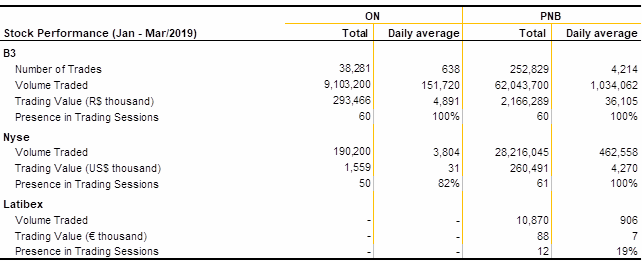
96
5 Tariffs
Power distribution tariffs

Power purchase tariffs

97
Power supply tariffs

6 Economic and Financial Results
Revenues (Note 32)
Until March 2019, net operating revenues were R$3,896,006, or 16.3% up against R$3,348,681 recorded in the same period in 2018.
This variation was mainly explained by:
a) 23.7% increase in Revenues from Electricity Sales to Final Customers, mainly caused by the 6.8% increase in the volume of energy sold to end consumers – mainly the 4.7% increase in consumption of the captive market of Copel DIS and 11.2% increase in consumption of the industrial free market of Copel GeT and Copel Comercialização – as well as the tariff adjustment of Copel DIS by 15.61%, effective June 24, 2018;
b) 6.9% increase in Revenues from Electricity Sales to Distributors, mainly caused by the increase in sales through regulated environment contracts, due to the start of operation of new projects;
c) 37.0% increase in Revenues from the Use of Main Distribution and Transmission Grid, mainly caused by the adjustment by 16.41% in June 2018 (0.85% in June 2017) and the recovery of the wire market by 5.1% in the period;
d) 19.4% increase in Revenues from Telecommunications, chiefly due to the increase in the number of clients, particularly in the retail market with the Copel Fibra product; and
e) 46.2% increase in Revenues from Distribution of Piped Gas impacted by the increase in gas sales due to the increase in the gas volume consumed, as well as a tariff adjustment by 16% compared to prior year;
f) 133.2% decrease in Sectorial Financial Assets and Liabilities, mainly caused by the amortization of the amounts considered in the 2018 adjustment and a slight variation in the balances for the 2019 adjustment; and
g) 46.5% increase in Other Operating Revenues due to the increase in revenue from services rendered and revenues from leases and rentals.
98
Operating Costs and Expenses (Note 33)
Operating costs and expenses totaled R$3,043,019, up by 9.2% compared to R$2,786,599 recorded in the same period in 2018. The main highlights were as follows:
a) 18.4% increase in Electricity purchased for resale, especially given the increase in energy purchases related to the trading company and the price variation in the period;
b) 27.1% decrease in Personnel and management mainly due to the provision for the voluntary employee termination program in the amount of R$91,152 recorded in 2018 and with no effects in 2019 due to the end of the program, the reduction of headcount and the cost reduction policy; partially offset by the salary adjustment, according to the collective bargaining agreement, of 3.97% in October 2018;
c) 25.7% increase in the Depreciation and amortization account due to the integration of Colíder, Cutia and Baixo Iguaçu plants, as well as higher depreciation of telecommunication assets; and
d) 11.6% decrease in the Credit losses, provisions and reversals account, mainly due lower amount of recorded labor contingencies compared to the same period in the prior year.
Financial Results (Note 34)
The variation of R$28,546 in financial results, corresponding to 41.0% compared to the same period in 2018, is mainly due to a 10.8% increase in financial expenses, due to higher monetary and exchange variations and debt charges.
EBITDA
EBITDA (earnings before interest, taxes, depreciation and amortization) is as follows:

The EBITDA is a non-accounting measure prepared by the Company, reconciled with its financial statements, in accordance with the provisions of Circular Letter/CVM/SNC/SEP 01/2007 and CVM Instruction 527/2012. It is not a measure recognized by accounting practices adopted in Brazil or international accounting standards, does not have a standard meaning and cannot be comparable to measures with similar titles provided by other companies. The Company discloses it because it is used to measure its performance.
99
The EBITDA cannot be considered separately or as a substitute of net income or operating income, as an indicator of operating performance or cash flow, or to measure the liquidity or the ability to pay debt.
100
COMPOSITION OF GROUPS RESPONSIBLE FOR GOVERNANCE
BOARD OF DIRECTORS | |
Chairman | Marcel Martins Malczewski |
Members | Daniel Pimentel Slaviero Marco Antônio Barbosa Cândido Carlos Biedermann Gustavo Bonini Guedes Luiz Claudio Maia Vieira Leila Abraham Loria Olga Stankevicius Colpo Adriana Angela Antoniolli |
STATUTORY AUDIT COMMITTEE | |
Chairman | Marco Antônio Barbosa Cândido |
Financial Expert Members | Carlos Biedermann Luiz Claudio Maia Vieira Leila Abraham Loria Olga Stankevicius Colpo |
SUPERVISORY BOARD | |
Chairman | Demetrius Nichele Macei |
Sitting Members | Harry Françóia Júnior Nilso Romeu Sguarezi Roberto Lamb Letícia Pedercini Issa Maia |
Deputy Members | Adrian Lima da Hora João Luiz Giona Jr Otamir Cesar Martins Vanessa Claro Lopes Gilberto Pereira Issa |
| |
EXECUTIVE BOARD | |
Chief Executive Officer | DANIEL PIMENTEL SLAVIERO |
Enterprise Management Officer | ANA LETÍCIA FELLER |
Chief Financial and Investor Relations Officer | ADRIANO RUDEK DE MOURA |
Chief Business Development Officer | Cassio Santana da Silva |
Chief Legal and Institutional Relations Officer | EDUARDO VIEIRA DE SOUZA BARBOSA |
Chief Governance, Risk and Compliance Officer | vicente loiácono neto |
Assistant Officer | DAVID CAMPOS |
| |
ACCOUNTANT | |
CRC-PR-045809/O-2 | ADRIANO FEDALTO |
| |
Information about this report: | |
Investor relations: | Phone: +55 (41) 3222-2027 ri@copel.com |
101
(Free Translation into English from the Original Previously Issued in Portuguese)
RELATÓRIO DO AUDITOR INDEPENDENTE
REPORT ON REVIEW OF INTERIM FINANCIAL INFORMATION
To the Shareholders and Management of
Companhia Paranaense de Energia – COPEL
Curitiba - PR
Introduction
We have reviewed the accompanying individual and consolidated interim financial information of Companhia Paranaense de Energia - COPEL (the “Company”), included in the Quarterly Information Form - ITR for the quarter ended March 31, 2019, which comprises the statement of financial position as at March 31, 2019 and the related statements of income, of comprehensive income, of changes in equity and of cash flows for the three-month period then ended, including the explanatory notes.
The Company’s Management is responsible for the preparation of this individual and consolidated interim financial information in accordance with technical pronouncement CPC 21 (R1) – Interim Financial Reporting and with international standard IAS 34– Interim Financial Reporting issued by the International Accounting Standards Board – IASB, as well as for the presentation of such information in accordance with the standards issued by the Brazilian Securities and Exchange Commission - CVM, applicable to the preparation of Quarterly Information - ITR. Our responsibility is to express a conclusion on this interim financial information based on our review.
Scope of review
We conducted our review in accordance with Brazilian and international standards on review of interim financial information (NBC TR 2410 and ISRE 2410 - Review of Interim Financial Information Performed by the Independent Auditor of the Entity, respectively). A review of interim financial information consists of making inquiries, primarily of persons responsible for financial and accounting matters, and applying analytical and other review procedures. A review is substantially less in scope than an audit conducted in accordance with the standards on auditing and, consequently, does not enable us to obtain assurance that we would become aware of all significant matters that might be identified in an audit. Accordingly, we do not express an audit opinion.
Conclusion on the individual and consolidated interim financial information
Based on our review, nothing has come to our attention that causes us to believe that the accompanying individual and consolidated interim financial information included in the Quarterly Information - ITR referred to above has not been prepared, in all material respects, in accordance with technical pronouncement CPC 21 (R1) and international standard IAS 34 applicable to the preparation of Quarterly Information - ITR and presented in accordance with the standards issued by the Brazilian Securities and Exchange Commission - CVM.
102
(Free Translation into English from the Original Previously Issued in Portuguese)
Emphasis of matter
Restatement of the financial information at March 31, 2018
On May 15, 2018, we issued an unmodified report on review of the Company’s interim financial information, which is now being restated. As described in note 3.6, the interim financial information at March 31, 2018 has been adjusted and is being restated as set out in CPC 23 – Accounting Policies, Changes in Accounting Estimates and Errors and CPC 26(R1) – Presentation of Financial Statements to reflect the effects from application of CPC 47 – Revenue from Contracts with Customers, in joint ventures, in calculating equity in earnings of investees. Our conclusion is not modified in respect of this matter.
Other matters
Statements of value added
We have also reviewed the individual and consolidated statements of value added (“DVA”) for the three-month period ended March 31, 2019, prepared under the responsibility of the Company’s Management, the presentation of which in the interim financial information is required by the standards issued by the CVM applicable to the preparation of Quarterly Information – ITR, and considered supplemental information by International Financial Reporting Standards - IFRS, issued by the IASB, which do not require the presentation of a DVA. These statements were subject to the same review procedures previously described and, based on our review, nothing has come to our attention that causes us to believe that they have not been prepared, in all material respects, in relation to the interim financial information taken as a whole.
Curitiba, May 14, 2019
DELOITTE TOUCHE TOHMATSU Auditores Independentes | Fernando de Souza Leite Engagement Partner |
103
SUPERVISORY BOARD’S OPINION ON THE INTERIM FINANCIAL INFORMATION FOR THE FIRST QUARTER OF 2019
The members of the Supervisory Board of Companhia Paranaense de Energia - Copel, undersigned, in accordance with their legal and statutory duties and responsibilities, have examined the Interim Financial Information for the 1st quarter of 2019 approved by the Company’s Board of Directors at the meeting held on this date. The minutes were received and assessed individually by the members prior to the meeting and were previously discussed with the Management and the independent auditors. Based on the work performed over the quarter, the analyses performed, the monitoring of discussions on internal controls and the clarifications provided by Management and the independent auditors and also considering the Limited Review Report of the Independent Auditors Deloitte Touche Tohmatsu Auditores Independentes, issued without qualifications, the members of the Supervisory Board declare that they are not aware of any facts or evidences that are not reflected in the Interim Financial Information for the quarter ended March 31, 2019 and conclude that this information may be disclosed.
Curitiba, May 14, 2019
/s/ DEMETRIUS NICHELE MACEI Chairman | /s/ HARRY FRANÇÓIA JÚNIOR |
| |
LETÍCIA PEDERCINI ISSA MAIA | /s/ OTAMIR CESAR MARTINS |
| |
/s/ ROBERTO LAMB | |
104
S T A T E M E N T
By this document, the Officers of Companhia Paranaense de Energia - Copel, publicly-held mixed capital company, with its headquarters at Rua Coronel Dulcídio nº 800,- PR, Curitiba - PR, enrolled with the National Registry of Legal Entities (CNPJ) under No. 76.483.817/0001-20, for the purposes of the provisions in item II, paragraph 1 of article 29 of CVM Instruction 480/2009, state that:
(i) We have reviewed and discussed and agree with the opinions expressed in the audit report of Deloitte Touche Tohmatsu Auditores Independentes related to the interim financial information of Copel included in the Quarterly Information Form - ITR as of March 31, 2019; and
(ii) We have reviewed and discussed and agree with the interim financial information of Copel included in the Quarterly Information Form - ITR as of March 31, 2019.
In witness whereof, we sign this document.
Curitiba, May 14, 2019
/s/ /s/
Daniel Pimentel Slaviero Ana Letícia Feller
Chief Executive Officer Chief Enterprise Management Office and Chief Governance, Risk and Compliance Officer (in office)
/s/ /s/
Adriano Rudek de Moura Cassio Santana da Silva
Chief Financial and Investor Relations Officer Chief Business Development
/s/
Eduardo Vieira de Souza Barbosa
Chief Legal and Institutional Relations Officer
Pursuant to the requirements of the Securities Exchange Act of 1934, the registrant has duly caused this report to be signed on its behalf by the undersigned, thereunto duly authorized.
| COMPANHIA PARANAENSE DE ENERGIA – COPEL |
| | |
| By: | /S/ Daniel Pimentel Slaviero
| |
| | Daniel Pimentel Slaviero
Chief Executive Officer | |
FORWARD-LOOKING STATEMENTS
This press release may contain forward-looking statements. These statements are statements that are not historical facts, and are based on management's current view and estimates of future economic circumstances, industry conditions, company performance and financial results. The words "anticipates", "believes", "estimates", "expects", "plans" and similar expressions, as they relate to the company, are intended to identify forward-looking statements. Statements regarding the declaration or payment of dividends, the implementation of principal operating and financing strategies and capital expenditure plans, the direction of future operations and the factors or trends affecting financial condition, liquidity or results of operations are examples of forward-looking statements. Such statements reflect the current views of management and are subject to a number of risks and uncertainties. There is no guarantee that the expected events, trends or results will actually occur. The statements are based on many assumptions and factors, including general economic and market conditions, industry conditions, and operating factors. Any changes in such assumptions or factors could cause actual results to differ materially from current expectations.
105














































































































































